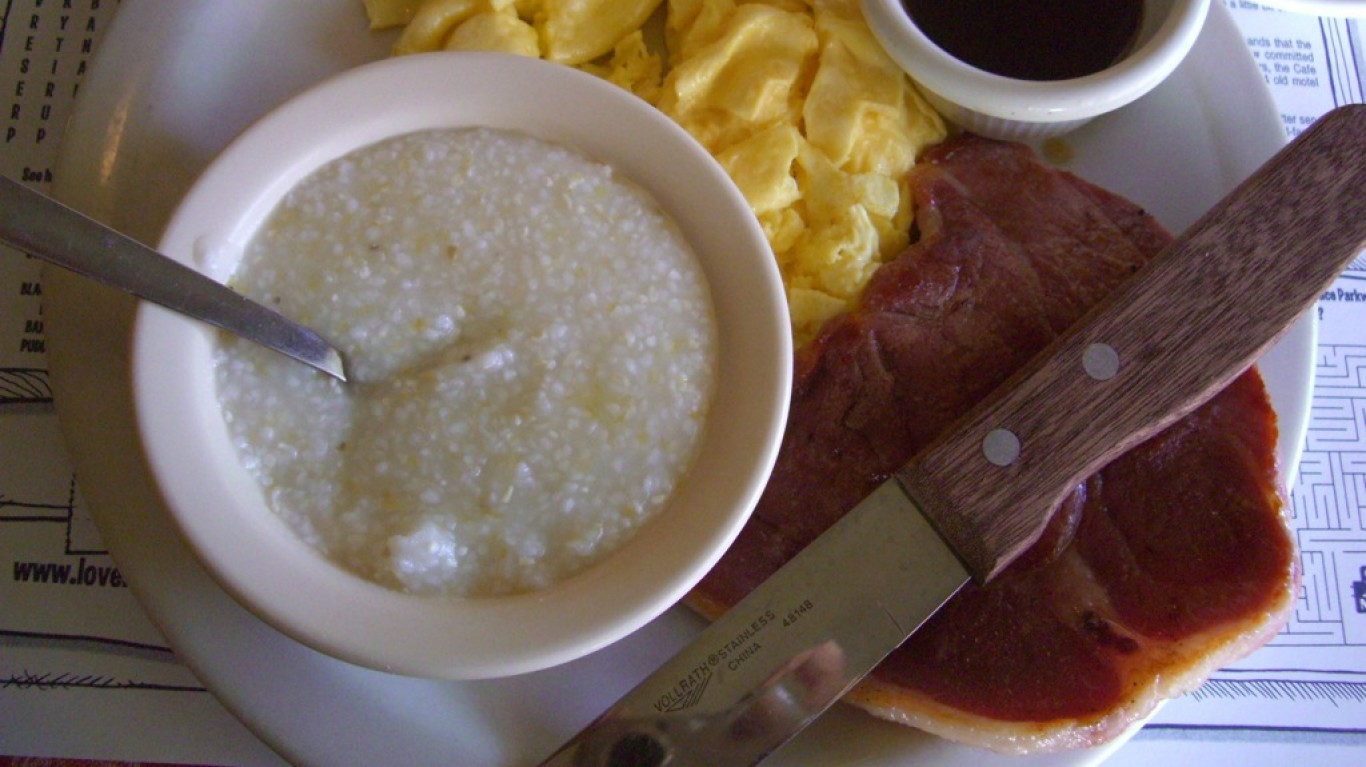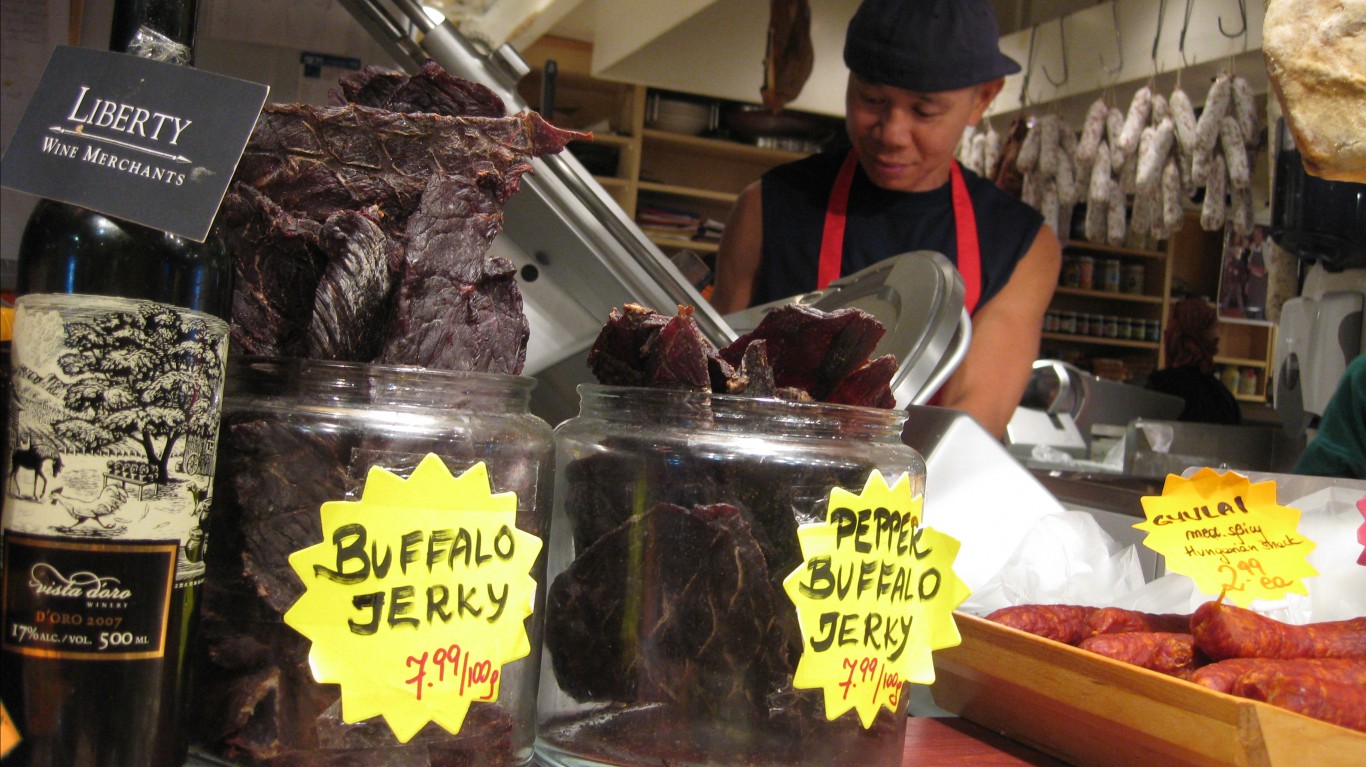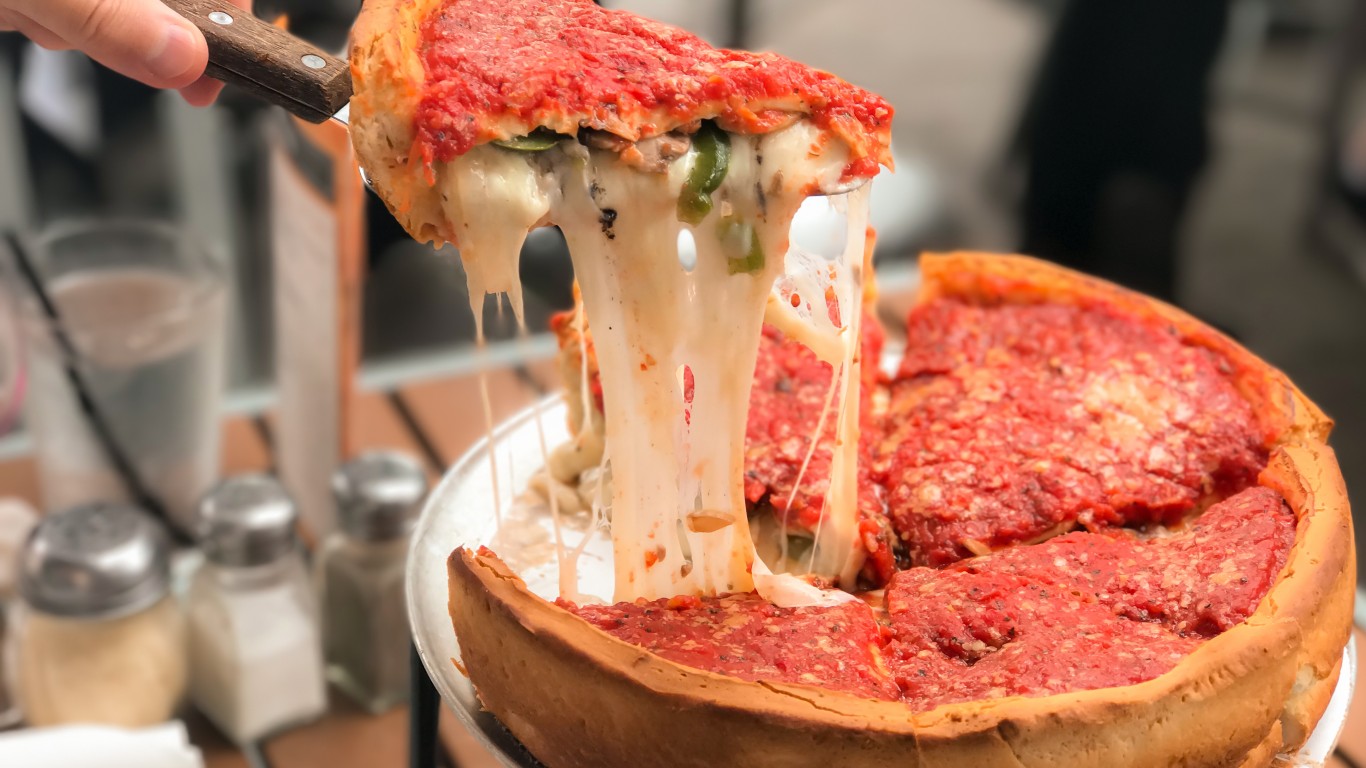
Each region of America has distinctive foods, from New England lobster to Southwestern enchiladas. But look closer and you’ll find certain dishes intrinsic to a state’s identity, even if barely known beyond its borders. (These are America’s most iconic dishes.)
Cuisine often reflects a state’s settlers – Mexican influences in the Southwest, European and Russian immigrants shaping the North and Midwest, and formerly enslaved people impacting Southern food. (These are iconic Southern foods every American should try.)
Some iconic state foods feature local ingredients, like Maryland crabs. Others arrived via immigrants, like German sausages in Wisconsin. Some were invented locally and remain popular domestically, like cheesesteaks in Philadelphia. And some are iconic for reasons largely unknown.
To compile a list of the most iconic dish in every state, 24/7 Tempo consulted listings in The Daily Meal, Food Network, Time Out, BuzzFeed, Southern Living, Thrillist, and Taste of Home, as well as numerous state-specific sites.
Click here to see the most iconic dish in every state
Alabama
> Iconic dish: Lane cake
Originating from a 1898 cookbook by Alabama native Emma Rylander Lane, the Lane Cake typically typically made with at least three layers of sponge cake separated by a filling that usually includes pecans, raisins, and shredded coconut soaked in liquor (usually brandy or bourbon). While popular at Southern weddings and celebrations, this liquor-soaked layered cake remains most closely tied to Lane’s home state.
[in-text-ad]
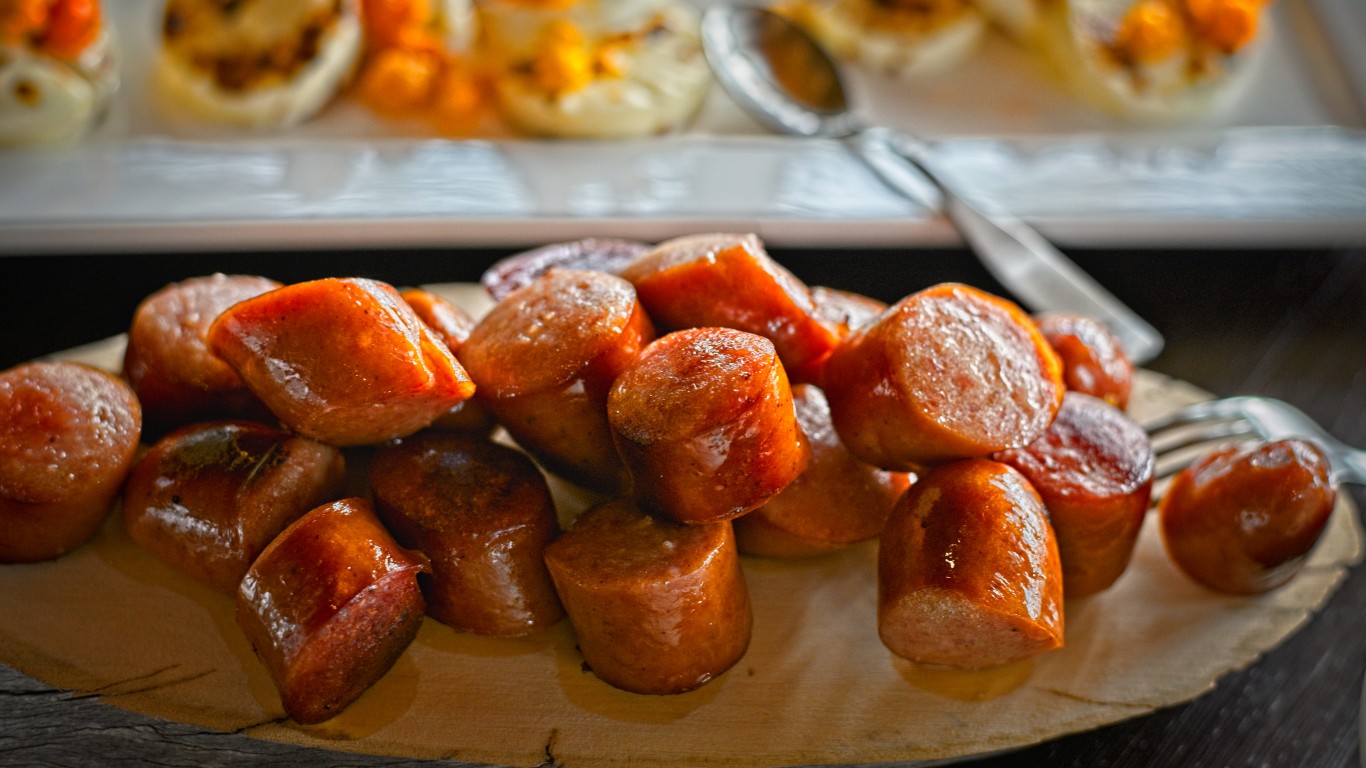
Alaska
> Iconic dish: Reindeer sausage
Sausage is popular globally, but Alaska uniquely offers reindeer sausage. Reindeer were first brought to Alaska in the 1890s by a missionary hoping to provide an additional food source for Inuits. Today, the distinctive meat is widely consumed, typically made into sausage combining reindeer with pork, beef, and spices before smoking.
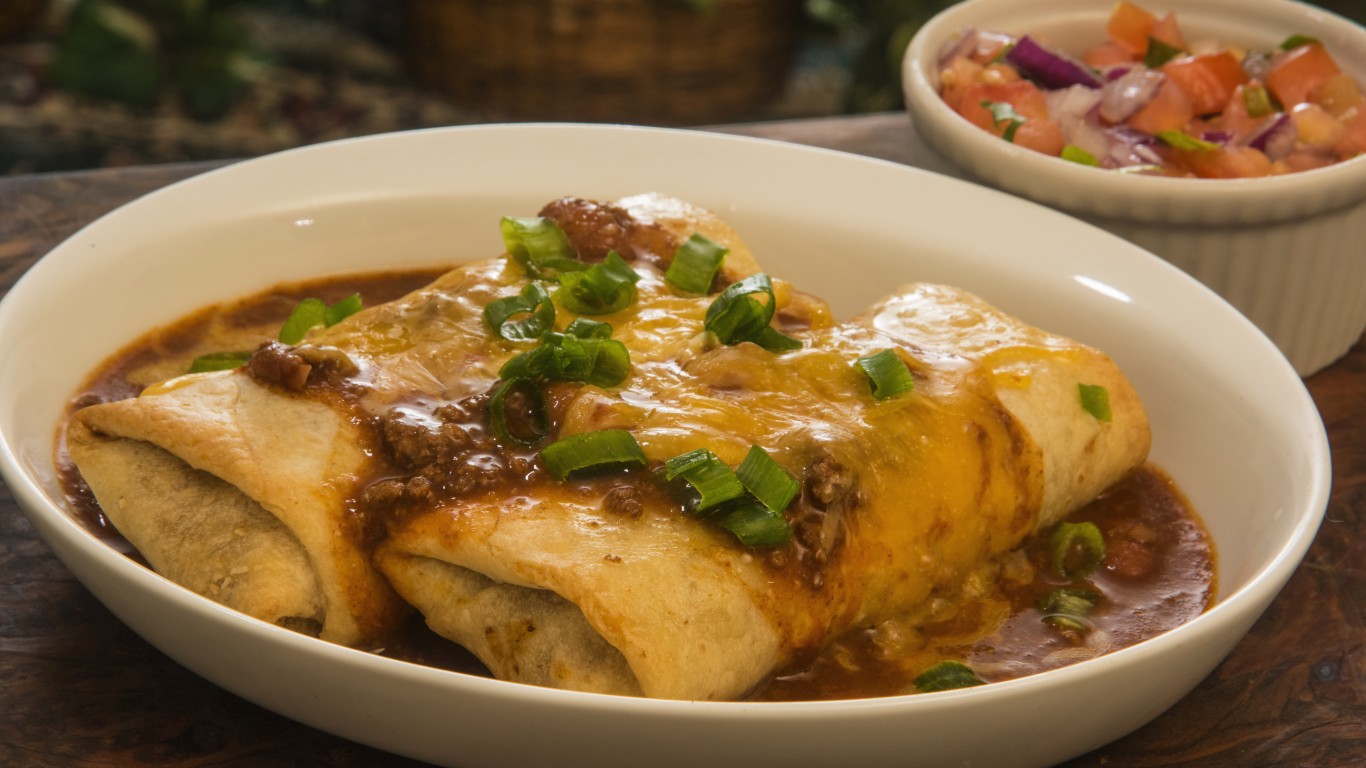
Arizona
> Iconic dish: Chimichanga
An iconic dish of the Southwest, especially Arizona, the chimichanga is a burrito that’s been deep-fried. Legend has it that it was invented by Monica Flin, the owner of a Tucson restaurant named El Charro, after she accidentally dropped a burrito into a deep-fryer. She gave it a Mexican Spanish word for “thingamajig,” and the dish’s popularity took off from there. Chimichangas are usually smaller than their Mission-style counterparts, and are typically topped with salsa and sour cream after frying.
Arkansas
> Iconic dish: Possum pie
Don’t be afraid: There’s no actual possum in Arkansas possum pie. This classic Southern dessert starts with a pecan-studded crust, which is topped with layers of a sweetened cream cheese mixture, chocolate pudding, and whipped cream, and finished with more pecans. It’s easy to make and doesn’t require any baking (except for the crust), so it’s a popular summertime treat at diners and church gatherings.
[in-text-ad-2]
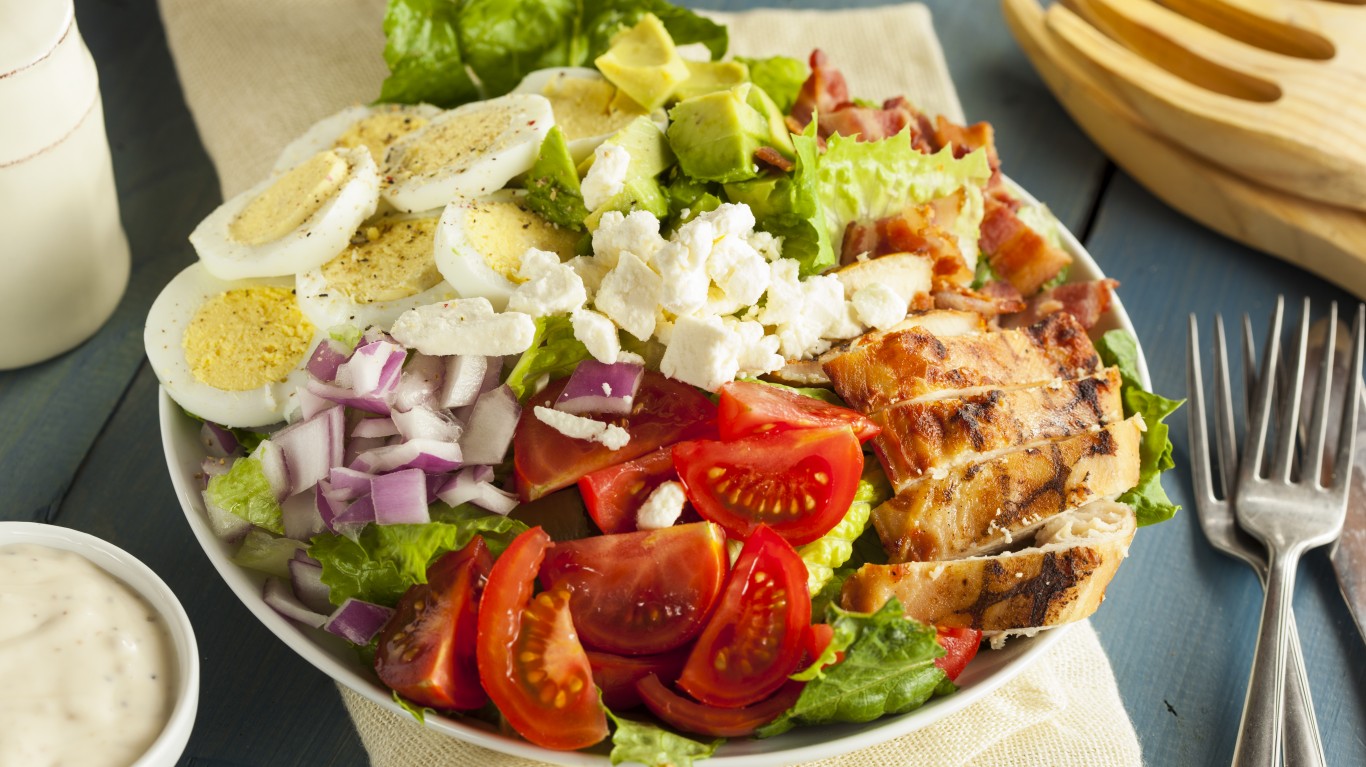
California
> Iconic dish: Cobb salad
The Cobb Salad is a brunchtime staple, invented in the 1930s at Hollywood’s legendary Brown Derby restaurant and named after its owner, Bob Cobb. Every restaurant that serves it puts their own spin on it, but at its most basic it’s a salad composed of chopped greens (traditionally iceberg, romaine, watercress, or endive), tomato, crispy bacon, diced chicken breast, hard-boiled egg, and avocado, arranged in neat rows or tossed and dressed in a red wine vinaigrette.
Colorado
> Iconic dish: Rocky Mountain oysters
If you see those on a menu, keep in mind that even though these may be called Rocky Mountain oysters, these are not seafood. They’re bull testicles that have been sliced thin, breaded, and deep-fried. Called prairie oysters in Canada, they’re a popular appetizer in Colorado, where they’re a hallmark of “cowboy fare” and commonly found at festivals and bars, where they’re frequently served with cocktail sauce.
[in-text-ad]

Connecticut
> Iconic dish: White clam pizza
The city of New Haven has a pizza style all its own, characterized by a thin, slightly oblong crust with a pronounced char from the coal-fired oven in which they’re cooked. The city also has a signature pizza topping: fresh chopped clams. The pizza’s birthplace, Frank Pepe, still serves the definitive version, which combines the clams with grated cheese, chopped garlic, and a drizzle of olive oil.
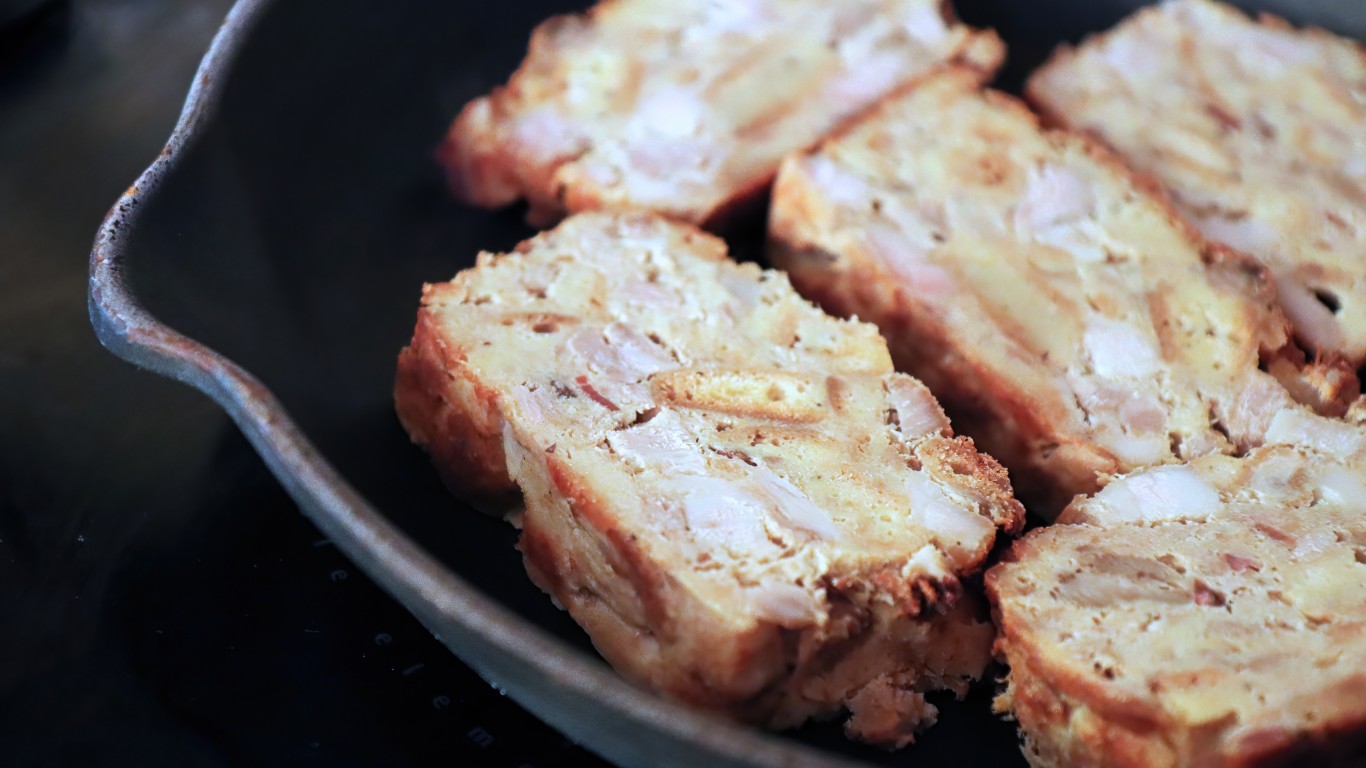
Delaware
> Iconic dish: Scrapple
A traditional Pennsylvania Dutch dish that’s commonly found in the Mid-Atlantic states (especially Delaware), scrapple is made by boiling pork scraps and offal with cornmeal and seasonings including sage, thyme, savory, and black pepper and forming it into a loaf. Once cooled, it’s sliced and either pan-fried or deep-fried until crisp. It’s a popular breakfast side dish, usually served with both sweet or savory condiments (including apple butter or mustard). Nowadays, many producers forgo the offal and make theirs with pork meat.

Florida
> Iconic dish: Key lime pie
The dessert most closely associated with the Florida Keys, Key lime pie is usually made by filling a graham cracker crust with a creamy filling made with Key limes (which are tarter and aromatic than the more common Persian limes), egg yolks, and sweetened condensed milk and topping it with meringue that’s been bruléed to golden brown.
[in-text-ad-2]
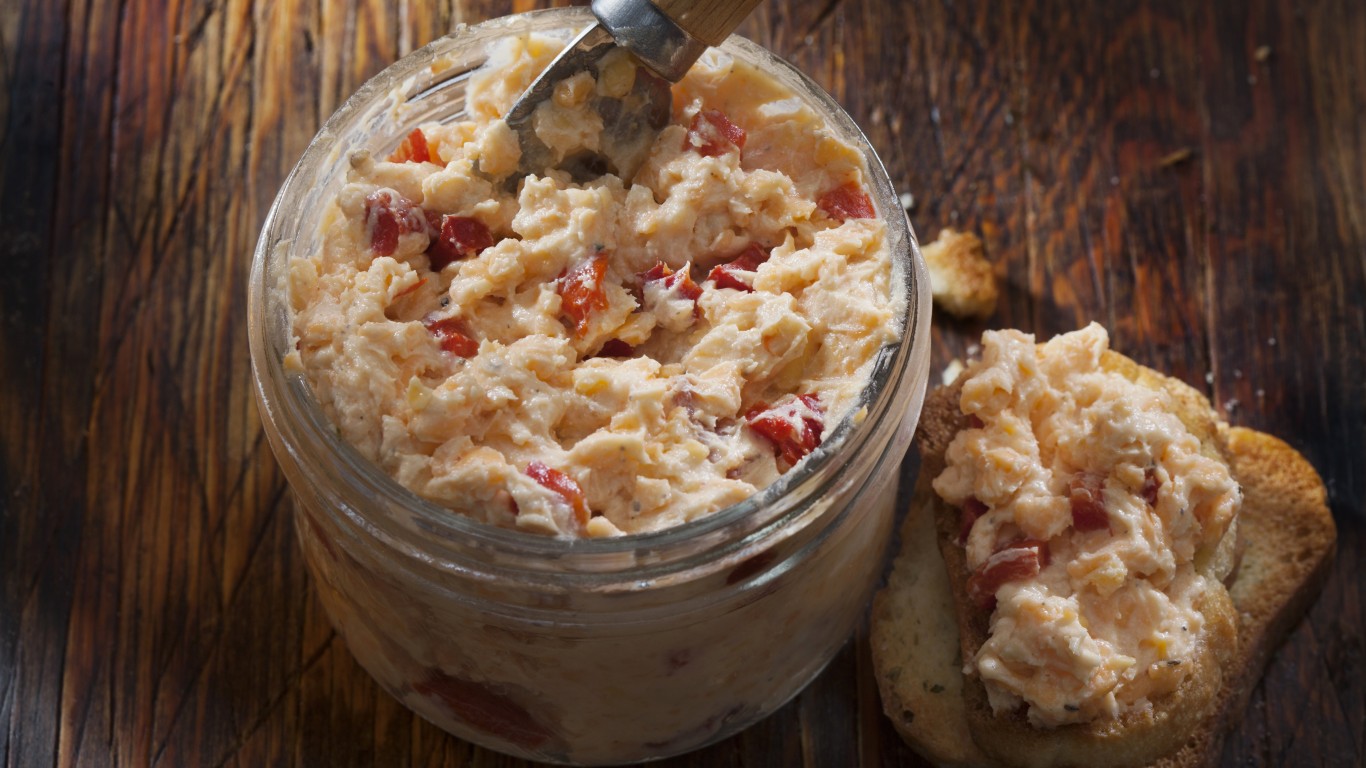
Georgia
> Iconic dish: Pimento cheese
Few dishes are more associated with the South (and Georgia especially) than pimento cheese, and just about every Southern chef has put his or her own spin on the recipe. At its most basic, it’s a mixture of mayonnaise, shredded cheddar or processed cheese, and diced pimentos, usually served on Ritz crackers, in a sandwich, with chips, or atop a burger or hot dog. Variations on the recipe can include worcestershire sauce, mustard, cream cheese, cayenne, and onion or garlic.
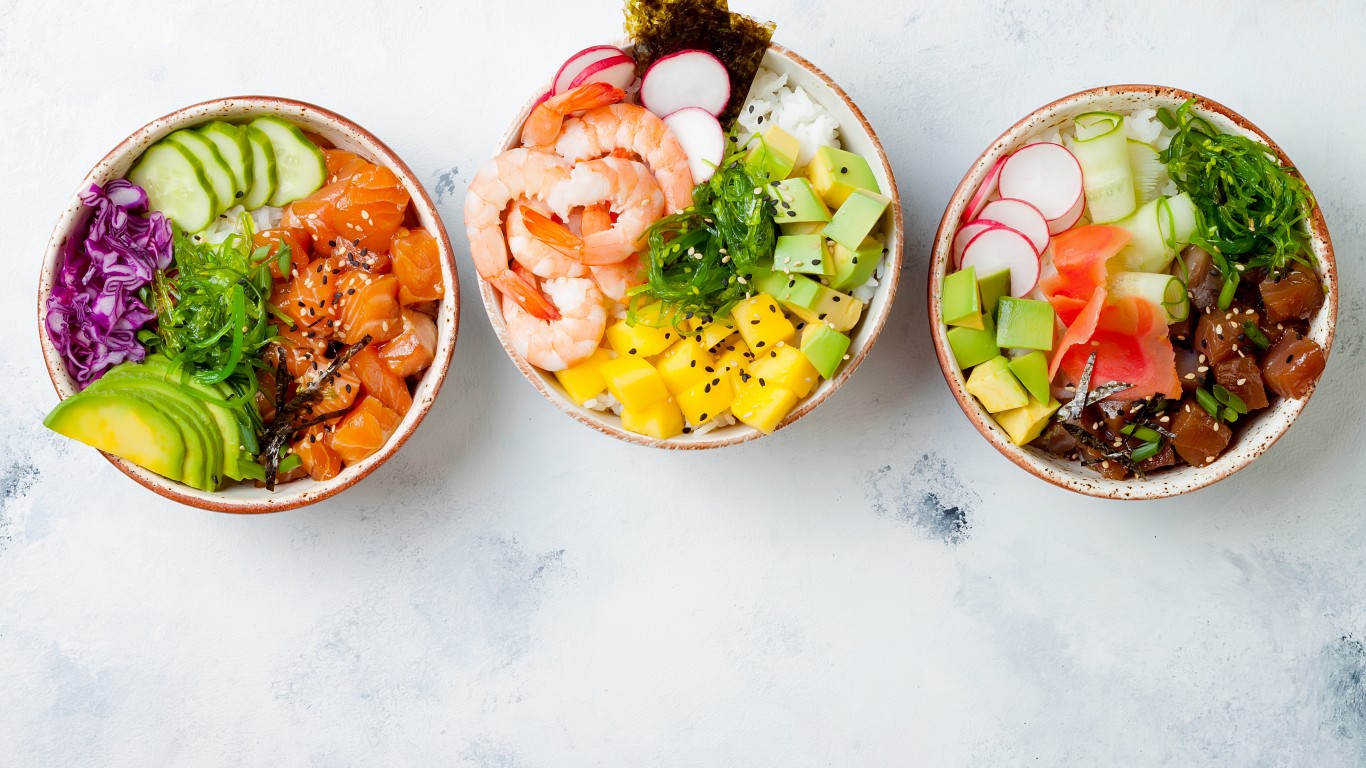
Hawaii
> Iconic dish: Poke
A basic dish of Native Hawaiian cuisine that’s become incredibly popular on the mainland in recent years, poke is made by slicing raw fish into cubes and tossing it with a wide variety of sauces and add-ins. Ahi tuna, salmon, and cooked sliced octopus are the most common proteins, and common accompaniments include soy sauce, sesame oil, green onions, seaweed, chopped chiles, roasted chopped candlenuts, and Maui onions. Many of the state’s top poke shops offer several varieties, made with super-fresh fish.
[in-text-ad]
Idaho
> Iconic dish: Spudnuts
If you’ve never heard of Spudnuts, then you’re not from Idaho. Idaho is the land of potatoes, and Spudnuts put them to good use, in doughnut form. To make them, potatoes are mashed and made into a traditional yeast dough before being deep fried and glazed. The potatoes keep them moist and add layers of richness and flavor. There was once a national chain specializing in the treats called Spudnuts, but few units remain.

Illinois
> Iconic dish: Deep-dish pizza
Love it or hate it, deep-dish pizza is Chicago’s most legendary culinary export. Purists argue that it’s more of a casserole than a pizza, but there’s no denying that it’s hearty and delicious. Nobody can say for certain who invented it, but most agree that it was popularized at the original Pizzeria Uno in the 1940s. To make traditional deep-dish, buttery dough is spread onto the bottom of a deep, round pan, then topped with plenty of cheese and various toppings (sausage is a favorite); then sauce is added, traditionally with a sprinkling of parmesan to finish.
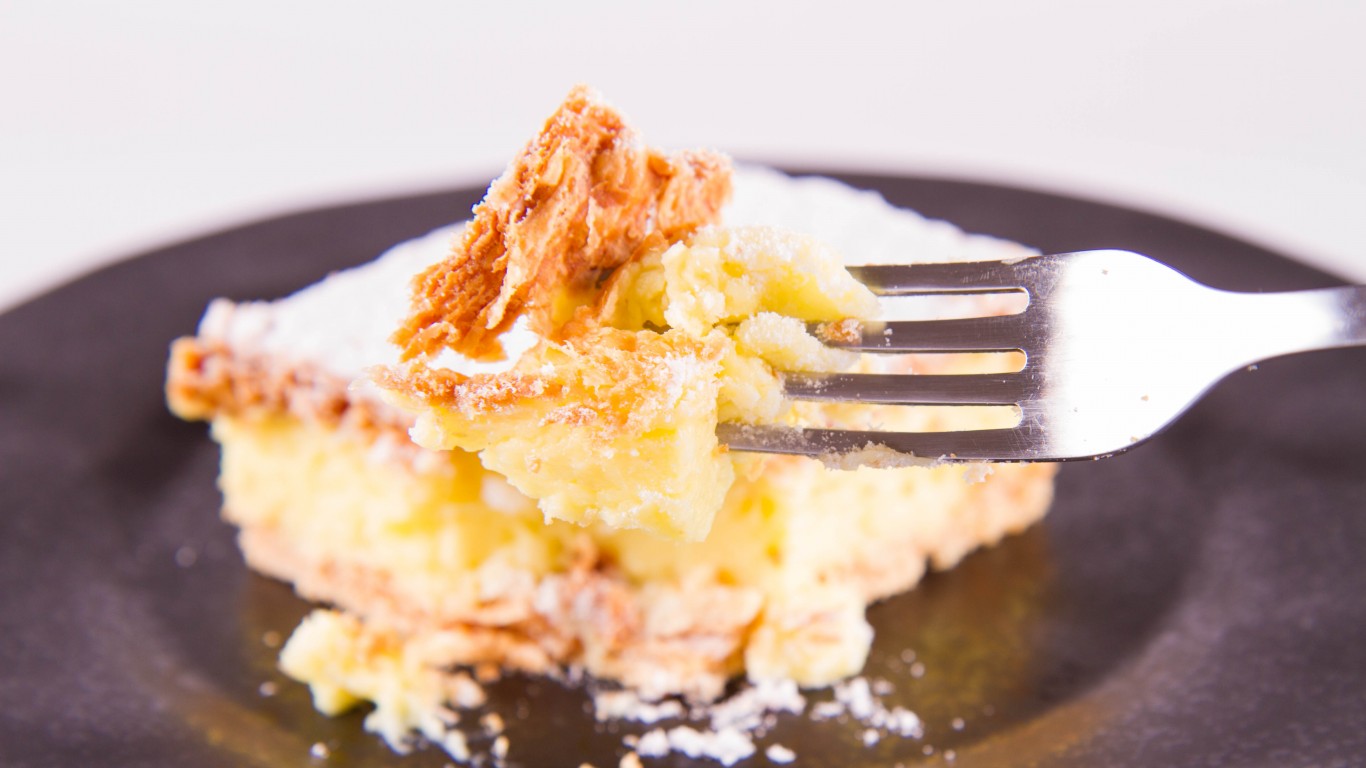
Indiana
> Iconic dish: Sugar cream pie
Just the name alone sounds magical, doesn’t it? Sugar cream pie, also called Hoosier sugar cream pie, is an Indiana specialty made by filling up a pie crust with a creamy mixture of flour, cream, butter, brown sugar, vanilla, and a pinch of salt and baking until it lightly caramelizes. It was brought to Indiana by Quaker settlers and popularized by the Amish, and it remains the unofficial state pie of Indiana.
[in-text-ad-2]
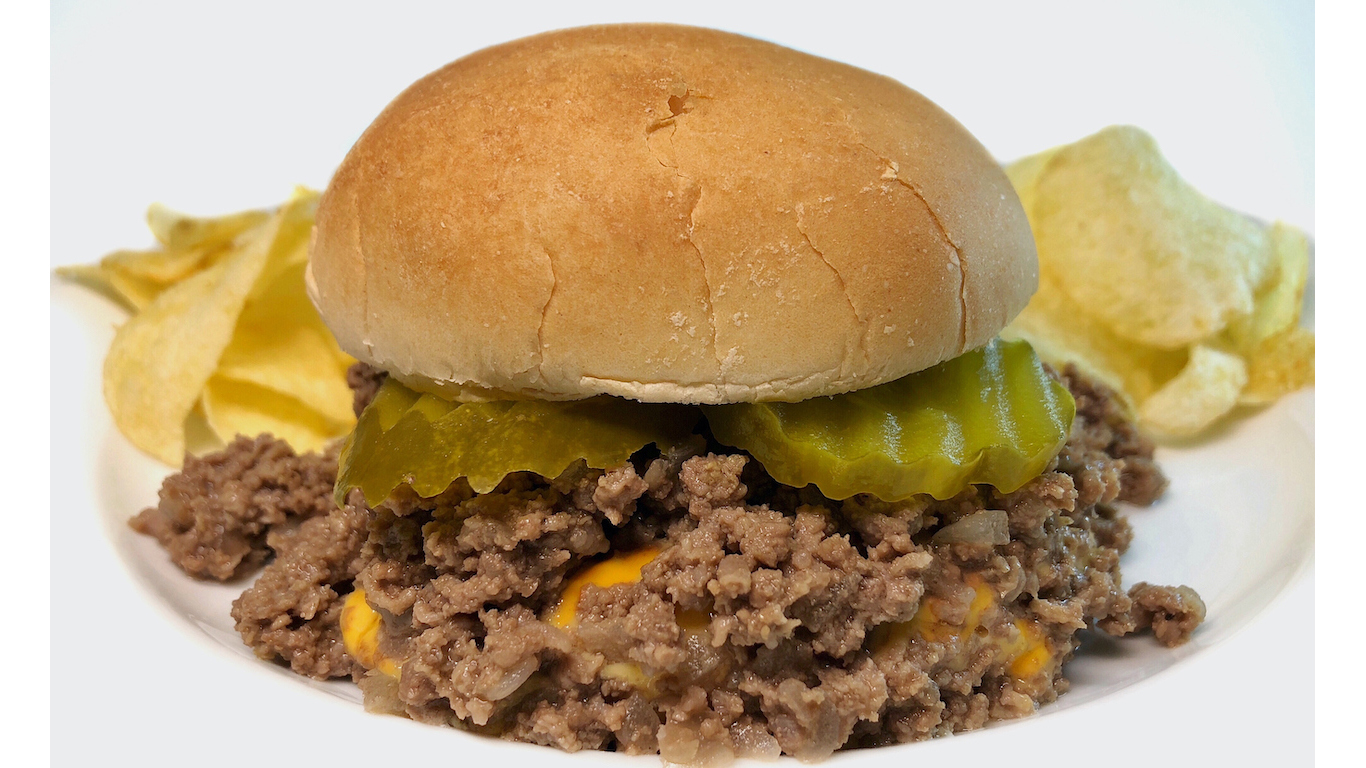
Iowa
> Iconic dish: Loose meat sandwich
If you’ve never had a loose meat sandwich, also called a tavern sandwich, think of it as a sloppy Joe without the sauce. Invented by Fred Angell in the 1920s at his restaurant (called Maid-Rite), this sandwich is made by cooking seasoned ground beef, mixing it with sautéed onions, spooning it onto a bun, and topping it with traditional burger accompaniments like ketchup, mustard, pickles, and cheese. Maid-Rite remains a popular Midwestern chain.
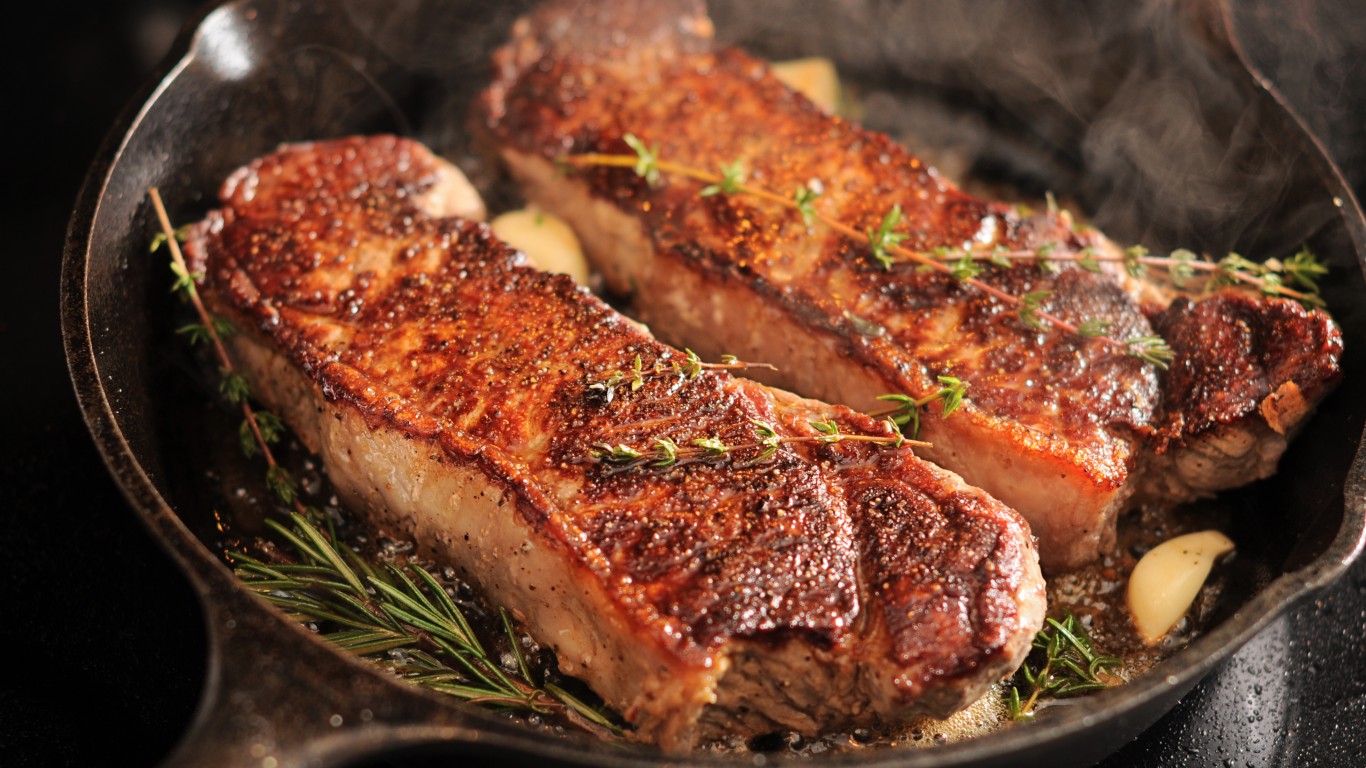
Kansas
> Iconic dish: Strip steak
Kansas City is a steak town (its famed stockyards processed millions of heads of cattle from 1871 to 1991), so when in Rome, do as the Romans do and dig into a Kansas City strip. Essentially the same as a New York strip, this steak is cut from the short loin and best enjoyed at famous Kansas City steakhouses including Jess & Jim’s, 801 Chophouse, Stock Hill, or Golden Ox.
[in-text-ad]
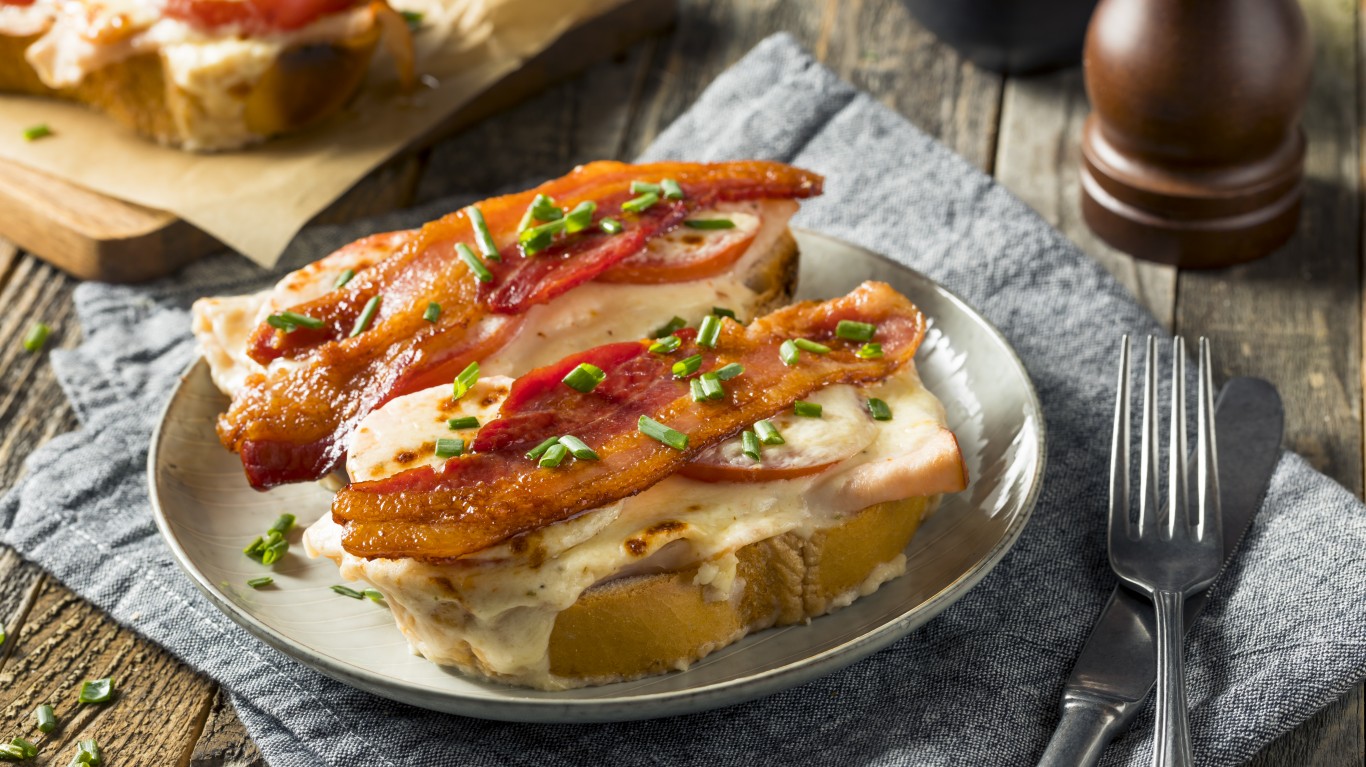
Kentucky
> Iconic dish: Hot Brown sandwich
The iconic open-faced Kentucky Hot Brown sandwich was invented at Louisville’s renowned Brown Hotel in 1926 by chef Fred K. Schmidt as a late-night alternative to ham and eggs. Consisting of toast topped with turkey, bacon, and creamy mornay sauce (béchamel with cheese added) that’s broiled until brown and finished with tomatoes, it’s rich and comforting. It can be found at restaurants all throughout Louisville, but the Brown Hotel still serves the definitive version.
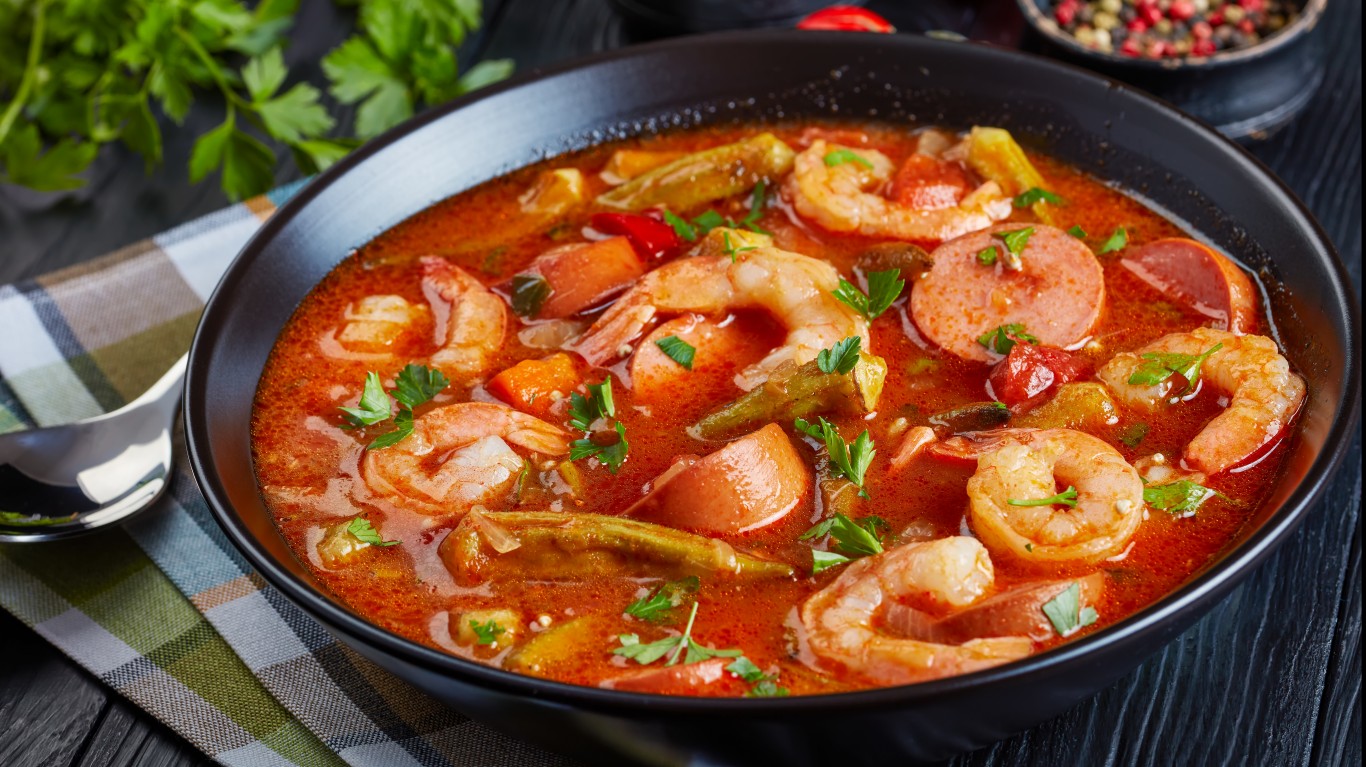
Louisiana
> Iconic dish: Gumbo
With po’boys, jambalaya, beignets, and more, New Orleans is home to countless legendary foods to call its own. No other dish is as iconic throughout Louisiana as gumbo, however; it’s actually the state’s official dish. It’s a rich stew made with a dark brown roux; the “holy trinity” of onions, bell peppers, and celery; a rich stock; and any combination of shrimp, chicken, sausage, or other meats. Gumbo is usually thickened with either okra or filé powder (dried, ground sassafras leaves), and served over rice.
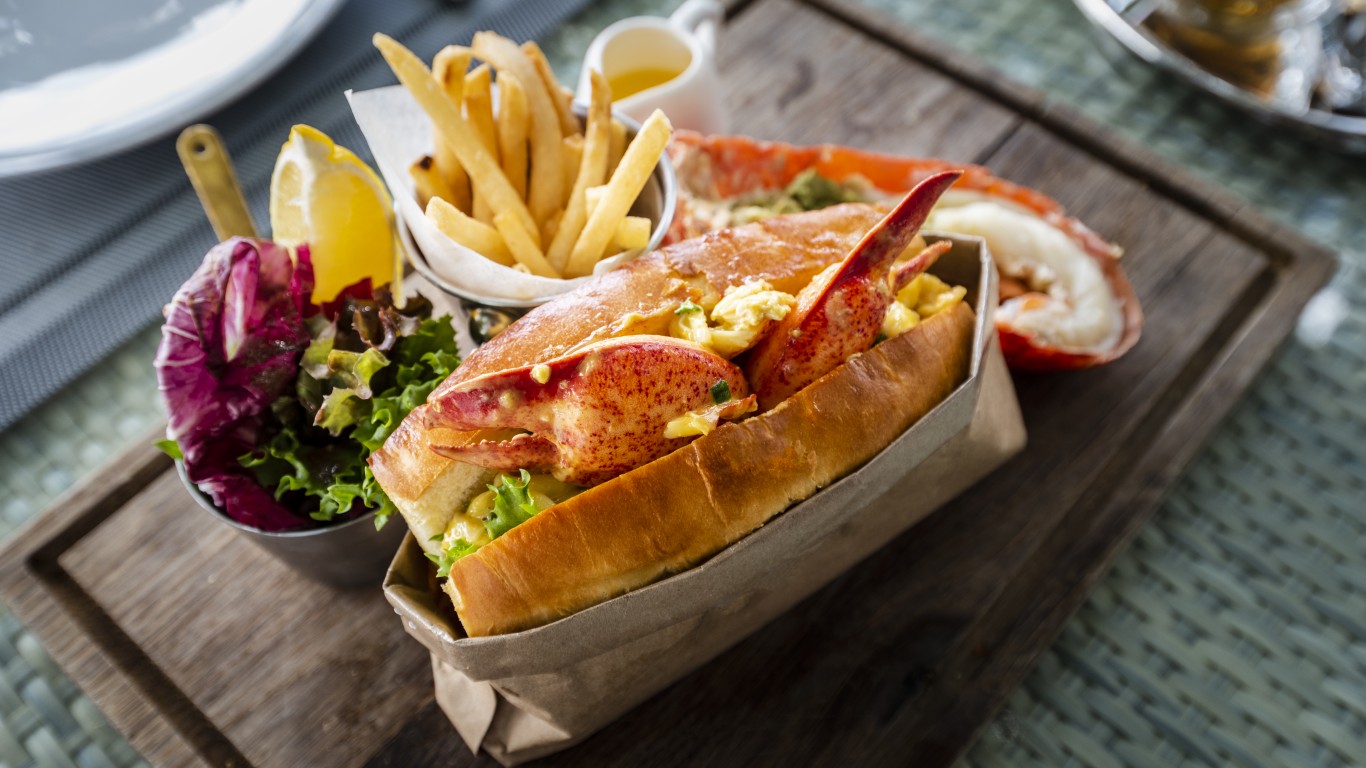
Maine
> Iconic dish: Lobster roll
If you’ve visited Maine and didn’t eat a lobster roll on the coastline, did you really visit Maine? While strapping on a bib and cracking into a whole steamed lobster is well and good, there’s something magical about taking a big bite of cold, super-fresh lobster, cut into chunks and tossed with a little mayo, tucked into a warm, buttered split-top bun while taking in views of the Maine coast. Lobster rolls are casual and luxurious at the same time, and countless shacks across Maine serve them on picnic tables overlooking the water.
[in-text-ad-2]
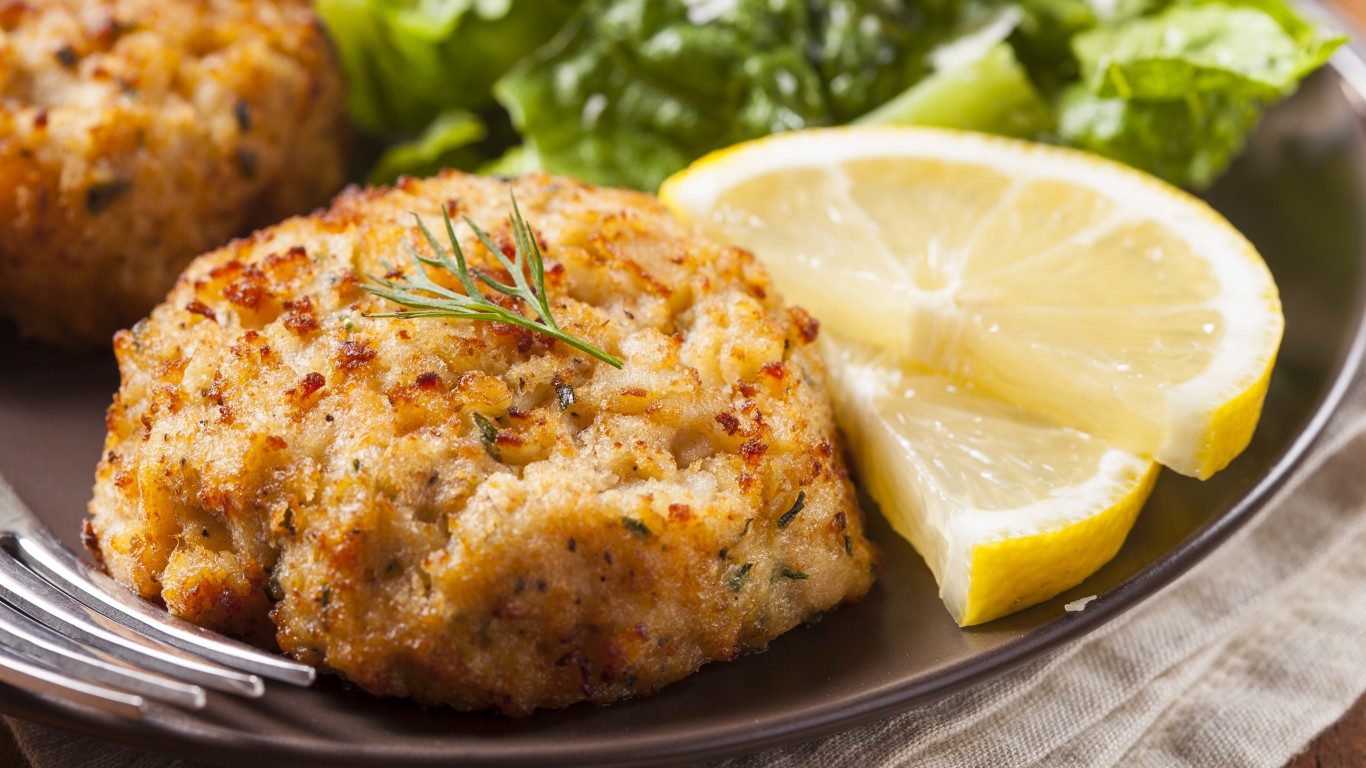
Maryland
> Iconic dish: Crab cakes
The Chesapeake Bay is brimming with blue crabs, and while it certainly can be fun to grab a mallet and go to town on a butcher-paper-covered table, the best way to enjoy the bounty of the bay is in crab cake form. At their best, they’re made with big chunks of fresh jumbo lump crab, tossed with just enough mayo and bread crumbs to bind it all together before being pan- or deep-fried. Most of Maryland’s top restaurants serve their own take on the dish, but they’re best enjoyed at casual spots on the waterfront.
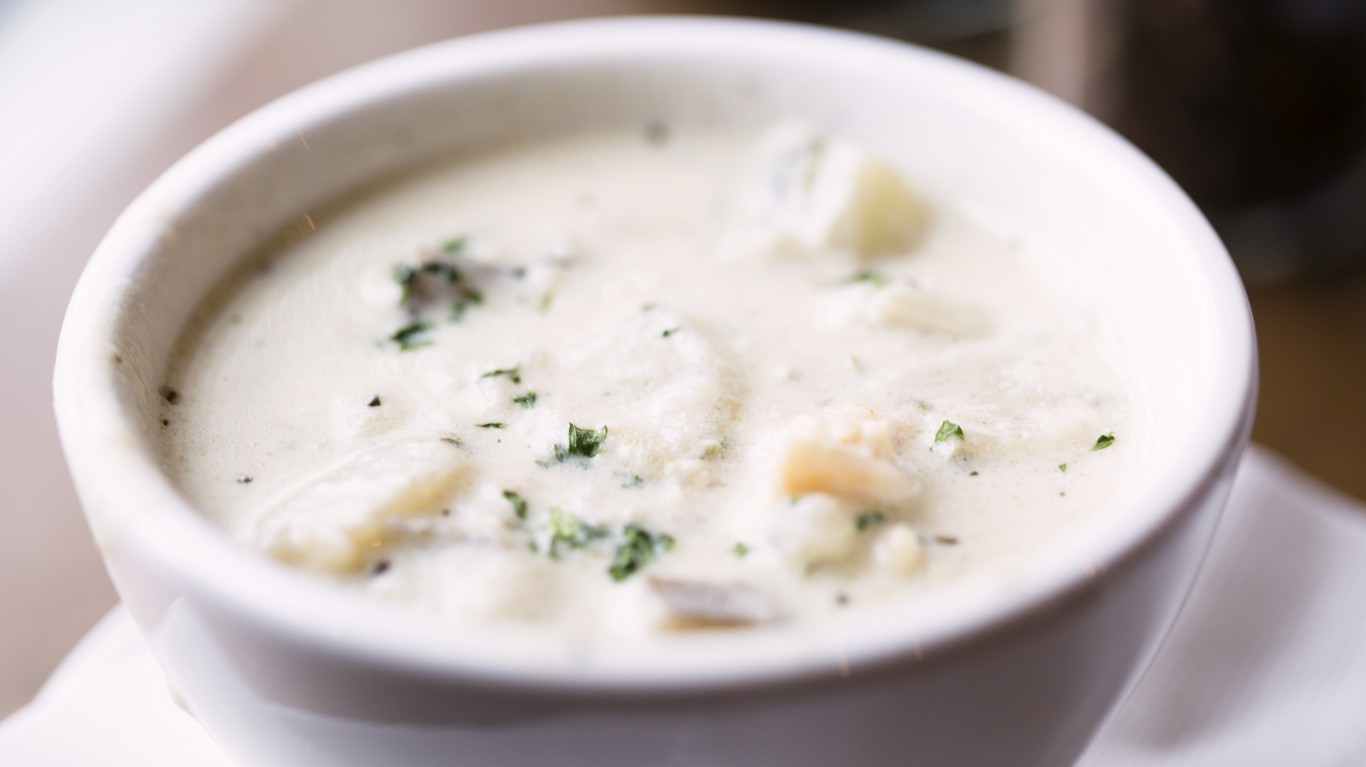
Massachusetts
> Iconic dish: Clam chowder
Did someone say chowdah?! Perhaps no food is more closely associated with Massachusetts than creamy New England clam chowder. As opposed to its tomato-based Manhattan cousin, this more popular chowder version is flour-thickened, with plenty of cream or milk, onion, potato, salt pork, and, most importantly, freshly-shucked clams. It’s the perfect bowl of goodness to warm you up on a cold Boston day.
[in-text-ad]
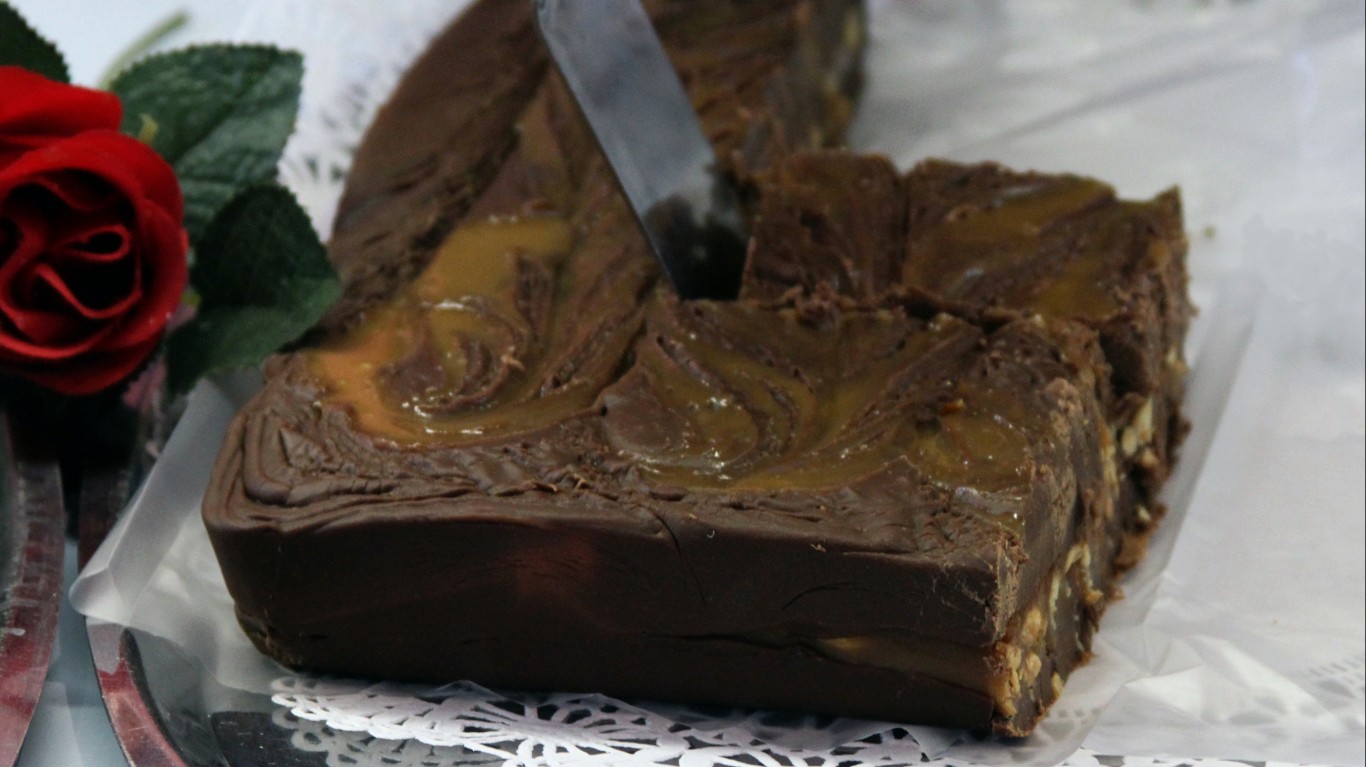
Michigan
> Iconic dish: Mackinac Island fudge
Mackinac Island is a 4.35-square-mile island at the very top of Michigan’s “glove,” and with its abundant nature, lack of cars, and slew of historic homes and hotels, it’s essentially a place where time stands still. In that vein, it’s also one of the best places in America to find that very old-timey treat, fudge. Fudge shops proliferate on the island, producing every flavor imaginable and supplying shops throughout the state.
Minnesota
> Iconic dish: Hotdish
A staple of church suppers, potlucks, and family reunions throughout Minnesota, hotdish is, at its simplest, a casserole that contains a meat, a canned or frozen vegetable, some type or canned soup for flavor, and a starch on top. The variations are endless, but a popular one contains ground beef, corn, cream of mushroom soup, and a top layer of Tater Tots. It’s inexpensive, tasty, easy to make, and hearty enough to feed a crowd, and it’s so popular that there are annual hotdish festivals and competitions.
Mississippi
> Iconic dish: Tamales
Tamales are most commonly associated with south-of-the-border cuisine, but they’ve taken on a life of their own in Mississippi. Called Delta-style tamales, these “hot tamales” were developed by African-Americans who came into contact with Mexican farm laborers and are made with coarse-ground cornmeal instead of masa; the filling more closely resembles spicy chili than anything else. They’re wrapped in corn husks and steamed or simmered, and sometimes served with ranch dressing.
[in-text-ad-2]
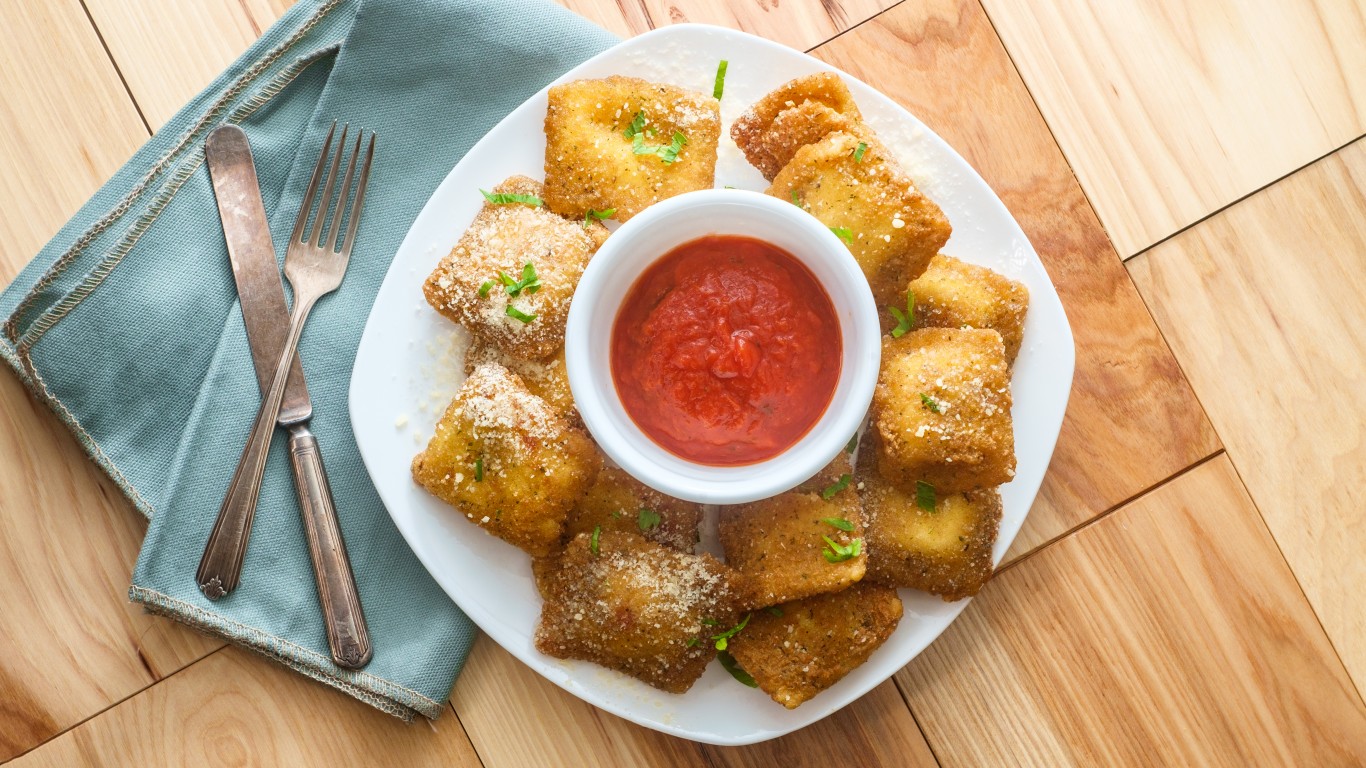
Missouri
> Iconic dish: Toasted ravioli
A staple in the historic St. Louis Italian neighborhood known as The Hill that’s become a beloved snack throughout the state, toasted ravioli (affectionately known as “t-ravs”) are made by breading and deep-frying meat ravioli, finishing them with a sprinkle of parmesan, and serving them with marinara sauce on the side. Charlie Gitto’s and Mama Campisi’s, both restaurants on The Hill, claim to have invented the dish in the 1940s, and remain the most famous spots to try it.

Montana
> Iconic dish: Huckleberry pie
Huckleberries resemble blueberries and are sweet with just a hint of tartness. They grow wild throughout Montana, where just about everyone guards their favorite huckleberry picking spot with utmost secrecy. They can be eaten fresh or turned into jam, but the best use of huckleberries is to bake them into a pie.
[in-text-ad]
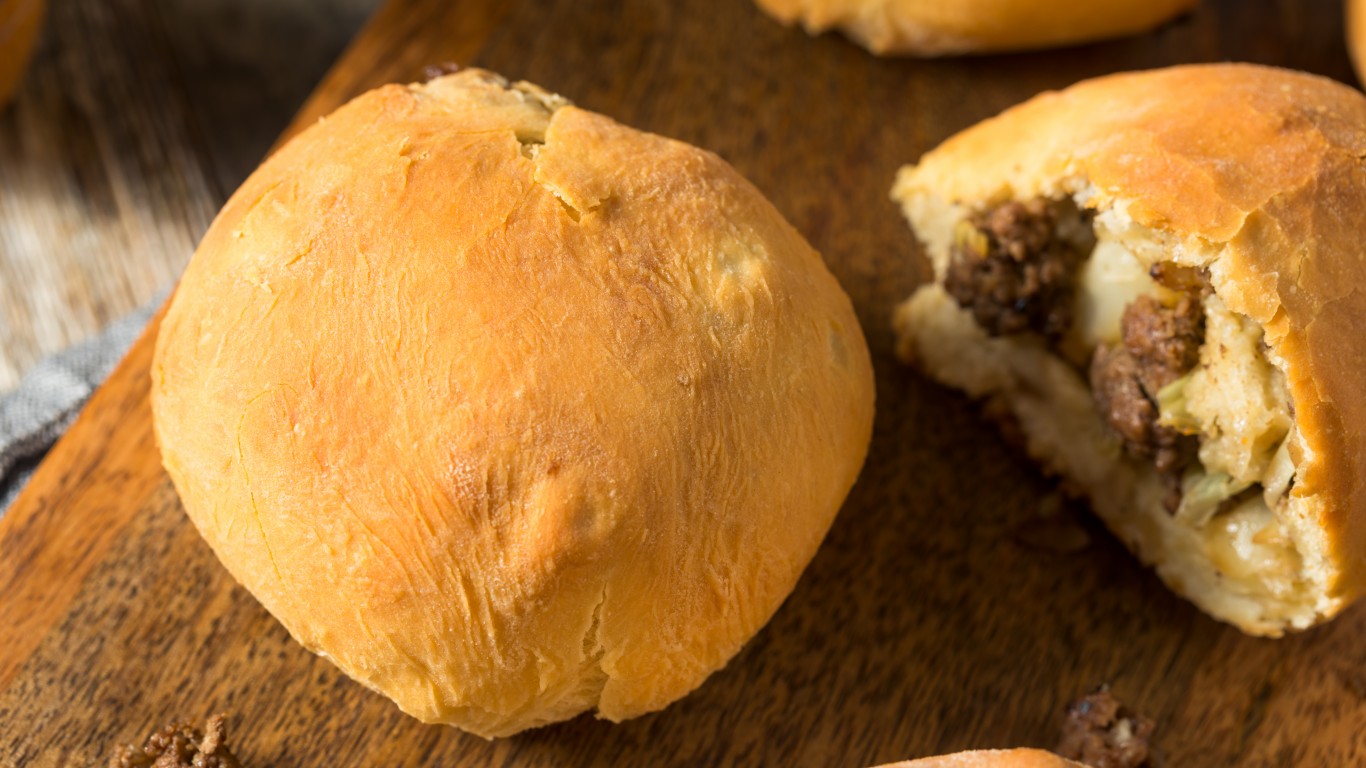
Nebraska
> Iconic dish: Runzas
A Nebraskan regional dish that’s been called “as Nebraskan as Cornhusker football,” the runza (also called a bierock) is a baked yeast-risen roll that’s been stuffed with a mixture of ground beef, onions, and/or sauerkraut, along with seasonings. It was brought by Volga Germans to the Great Plains in the 1900s, and comes in a variety of shapes and fillings. There’s also a popular Nebraska chain that specializes in Runzas called, appropriately enough, Runza.
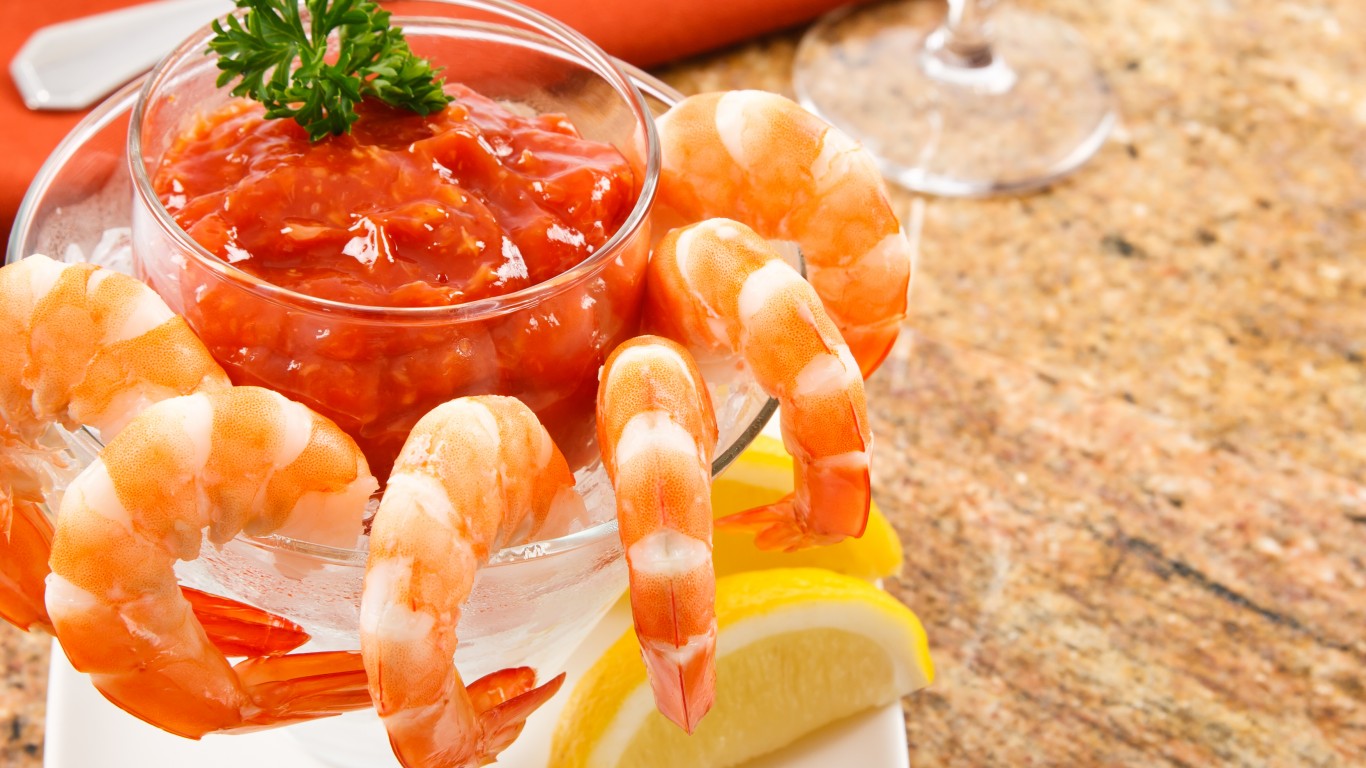
Nevada
> Iconic dish: Shrimp cocktail
Nevada doesn’t have too many regional culinary specialties to call its own, but there’s one dish that’s basically inescapable if you happen to find yourself at a casino restaurant, buffet, or steakhouse in Las Vegas or Reno: shrimp cocktail. Big, heaping piles of the pink crustaceans are essentially a given at buffets there, and no steak dinner is complete without an appetizer of cold poached shrimp with cocktail sauce.
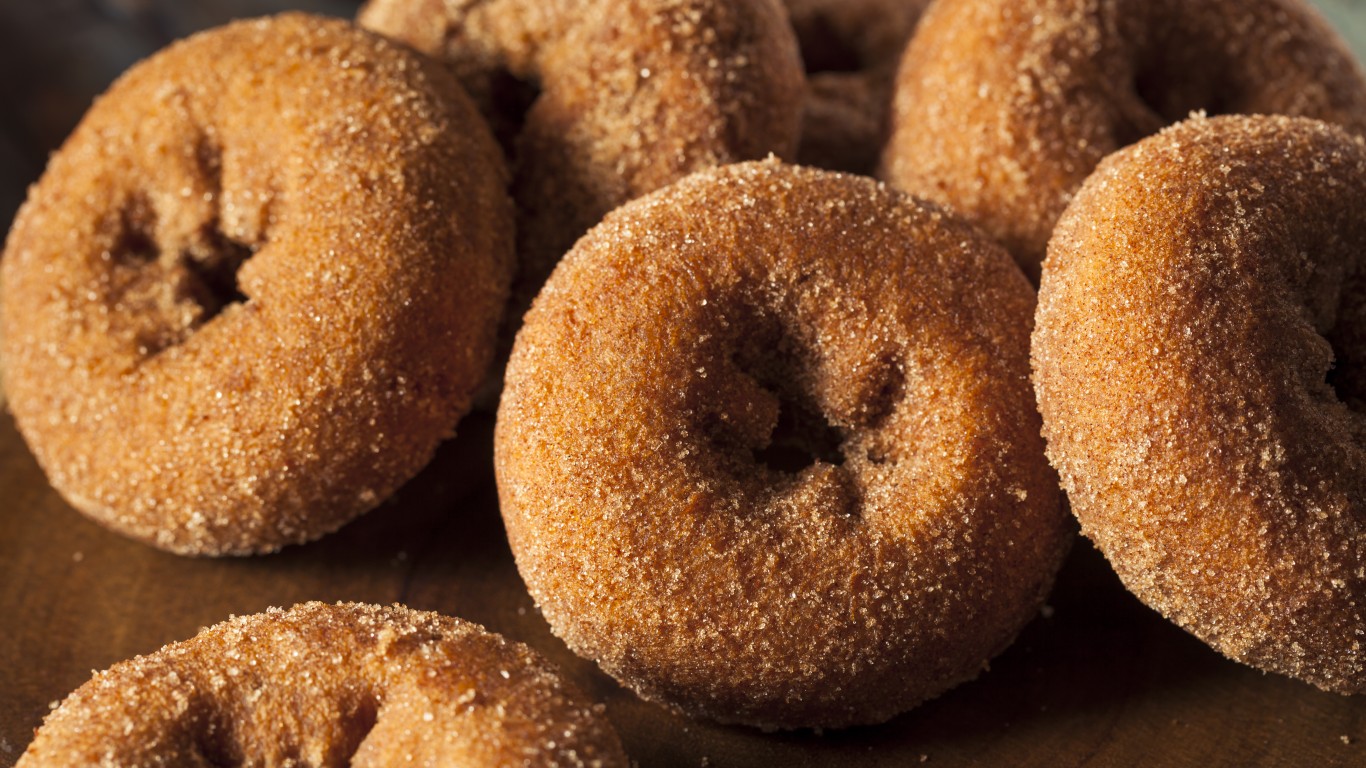
New Hampshire
> Iconic dish: Apple cider doughnuts
Apple trees are abundant throughout New England (especially New Hampshire), and come autumn the apple cider is cold, fresh, and free-flowing. Combining apple cider with hot, fresh doughnuts? A match made in heaven. A common autumn sight at bakeries and farmers markets throughout New Hampshire, apple cider doughnuts are made with warm spices including cinnamon, nutmeg, and allspice as well as a splash of apple cider, and rolled in cinnamon-sugar when they’re hot out of the fryer.
[in-text-ad-2]
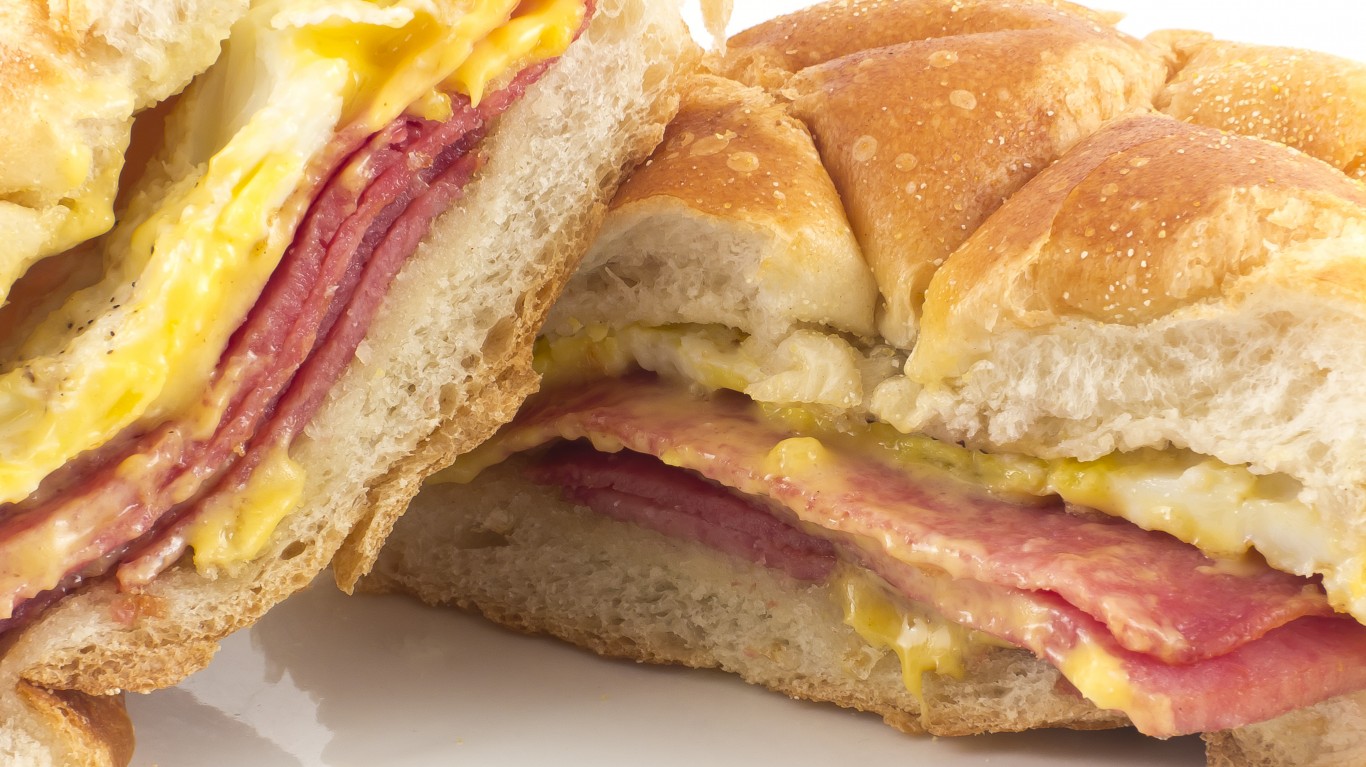
New Jersey
> Iconic dish: Pork roll
Call it Taylor Ham in North Jersey or pork roll in South Jersey, but no matter what you call it, it’s the foundation of a perfect breakfast sandwich. Pork roll was invented in the 1850s by John Taylor in Trenton, New Jersey, and it’s a processed meat that’s about the shape of bologna. It has a porky, salty, slightly smoky flavor all its own, and it’s best when sliced, crisped up in a frying pan, and served on a hard roll with egg and cheese.
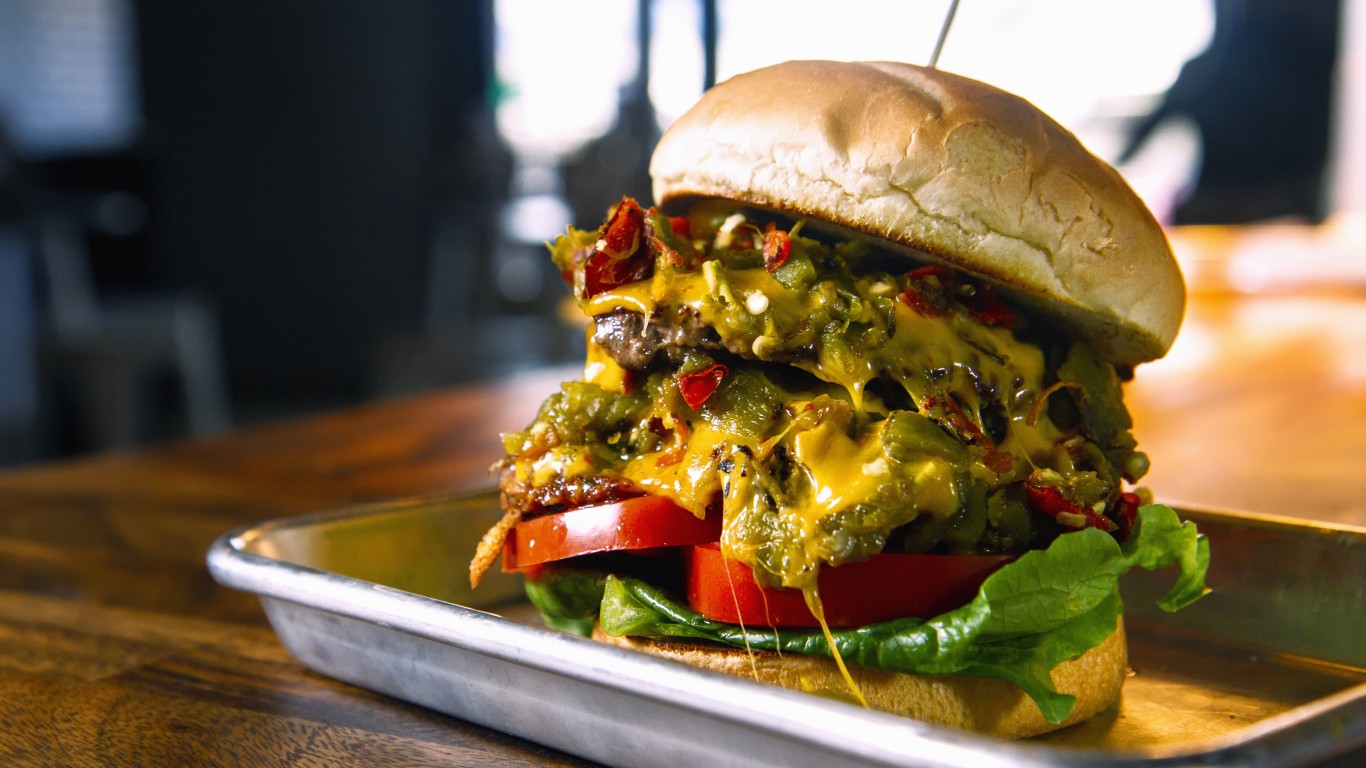
New Mexico
> Iconic dish: Green chile burger
Hatch green chiles are a way of life in New Mexico. They’re usually roasted and chopped into a sauce-like consistency, and from there the possibilities are endless; they show up in omelettes, topping burritos and enchiladas, in mac & cheese, in chilis and stews, and even in apple pie. But there’s nothing quite like the alchemy of flavors in a green chile burger. The bright spiciness of the chiles cuts through the richness of the beef and cheese, resulting in one of the finest burgers on earth.
[in-text-ad]
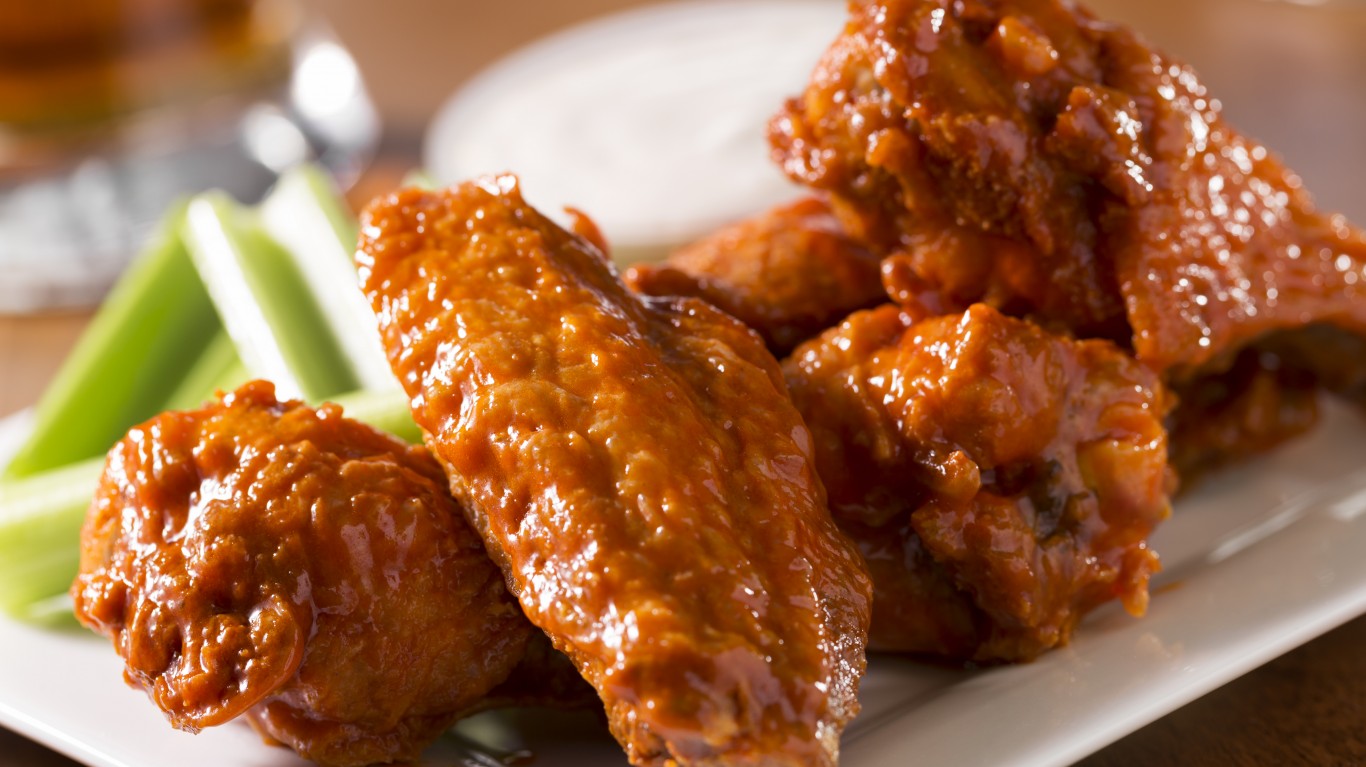
New York
> Iconic dish: Buffalo wings
Bagels, pizza, and pastrami all have iconic status in New York City, but head northwest to Buffalo, and you’ll be in the birthplace of the snack that really took over the country. As the story goes, Buffalo wings were invented at the city’s Anchor Bar back in 1964, back when chicken wings were usually thrown away or used in stocks. When owner Theresa Bellissimo’s son came into the bar late at night with some friends, she needed to cook up a snack for them, so she took some wings, deep-fried them, and tossed them in hot sauce. They were a hit, and their popularity exploded. Buffalo remains wing central, with Anchor Bar attracting millions of pilgrims every year.
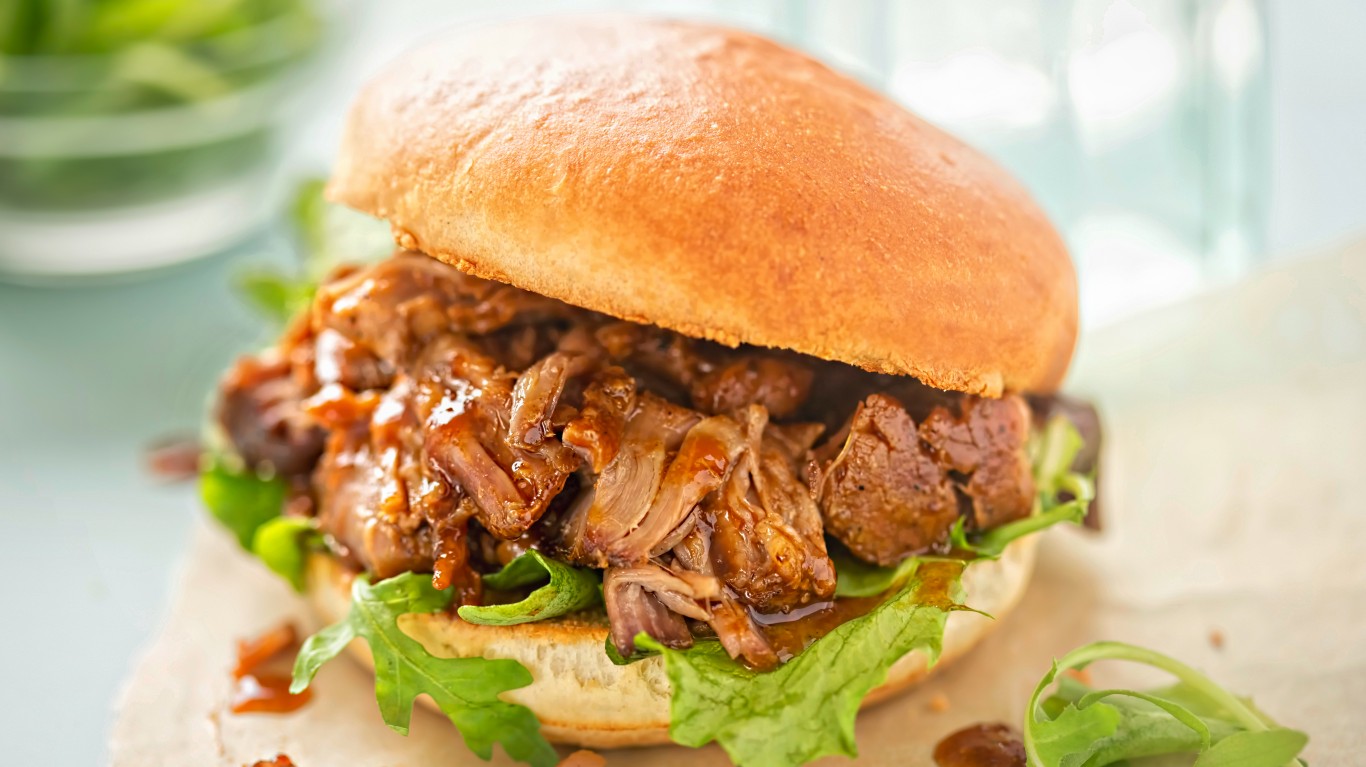
North Carolina
> Iconic dish: Pulled pork
If brisket is king in Texas and ribs in the Midwest, in North Carolina it’s all about the pulled pork. There are two primary pulled pork styles in North Carolina: Eastern North Carolina, where whole hogs are slowly smoked over hardwood charcoal before being pulled and doused with a tangy, spicy, vinegar based sauce; and Western North Carolina, where pork shoulders are smoked, pulled, and served with a ketchup-based red sauce. This is also referred to as Lexington-style barbecue, because the town of Lexington is home to dozens of BBQ joints.
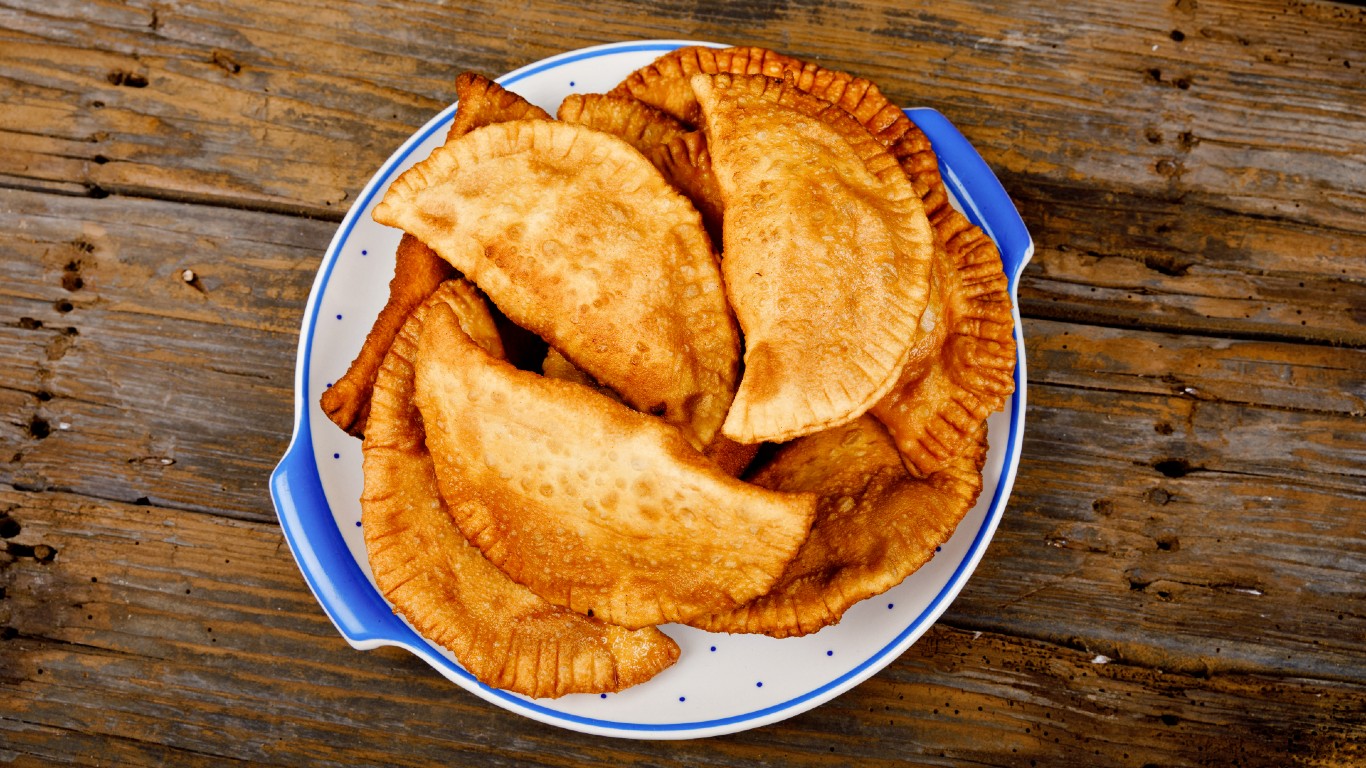
North Dakota
> Iconic dish: Fleischkuekle
The fleischkuekle was brought to North Dakota by Russian-German immigrants, and remains a hallmark of the state’s regional cuisine to this day. It’s a deep-fried handheld turnover, filled with seasoned ground beef and spices. It’s found at many small-town restaurants throughout the state, and is also crowd-pleasers at family gatherings.
[in-text-ad-2]
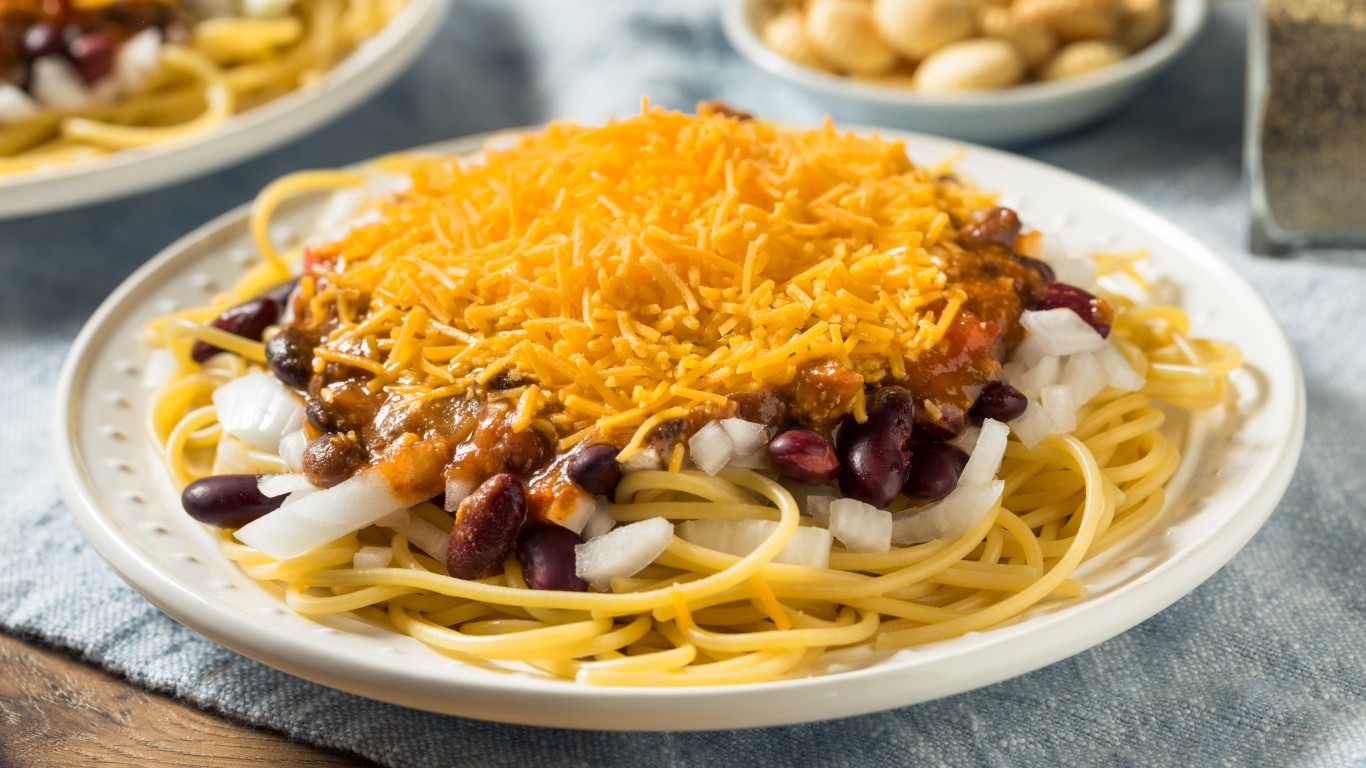
Ohio
> Iconic dish: Cincinnati chili
The term “chili” usually connotes a thick stew of ground beef, beans, tomatoes, and spices, but if you travel around the country you’ll notice that there are a whole lot of variations (no beans or tomatoes in Texas, for instance). In Cincinnati, chili is more of a sauce, made with ground beef, tomato paste, water, and a slew of spices including cinnamon, nutmeg, clove, cumin, and chili powder. Iconic “chili parlors” like Blue Ash and Skyline Chili have become legendary for serving the chili, which was invented by Greek immigrants, on hot dogs, burgers, and, most famously, on top of spaghetti. There’s even a lingo for it: “two-way” is plain, “three-way” is topped with finely shredded cheese, and “four-way” or “five-way” adds onions and/or beans.
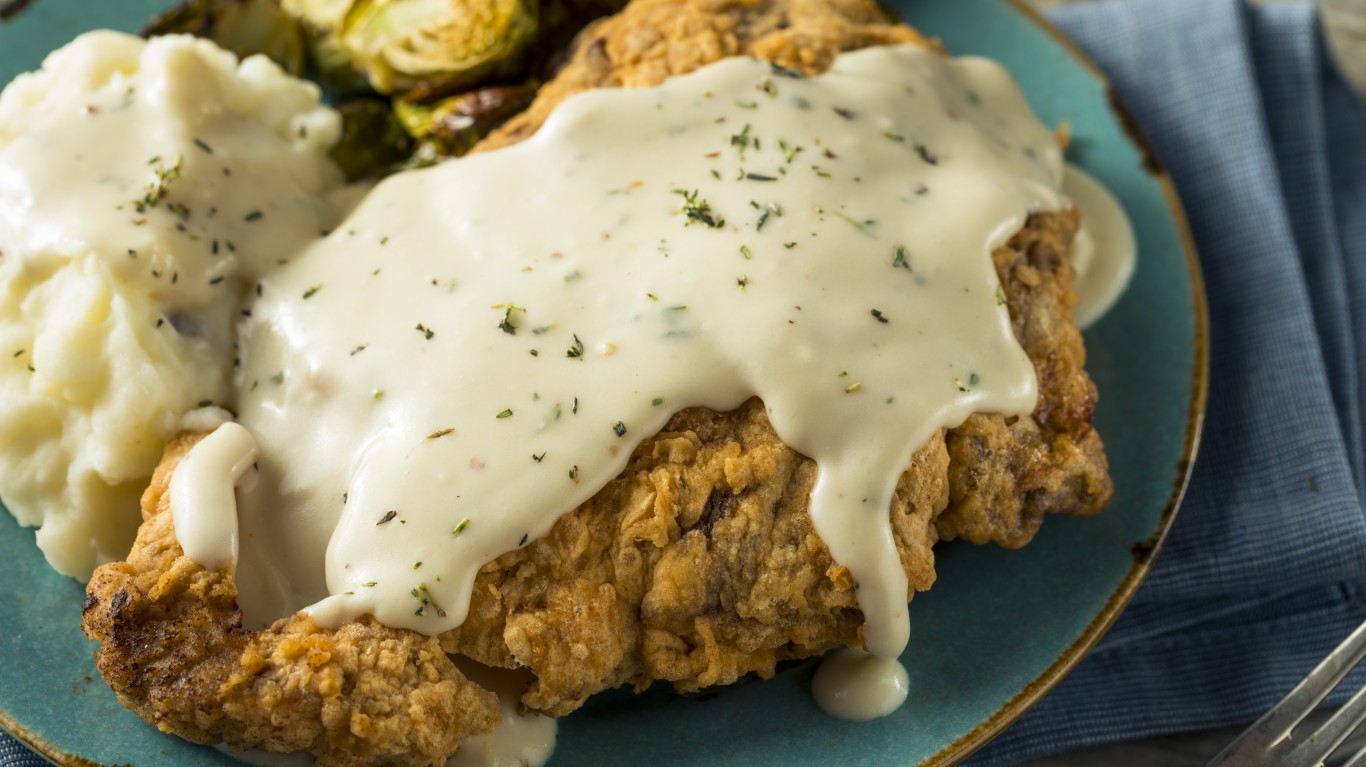
Oklahoma
> Iconic dish: Chicken-fried steak
Visit just about any casual restaurant in Oklahoma, and you’re bound to see chicken-fried steak on the menu. If you’re not familiar with the dish, there’s no actual chicken involved: A steak is pounded thin before being breaded and fried in the style of fried chicken. To make this legendarily artery-clogging dish even healtier, it’s usually served doused with cream-based, black-pepper-kicked gravy.
[in-text-ad]
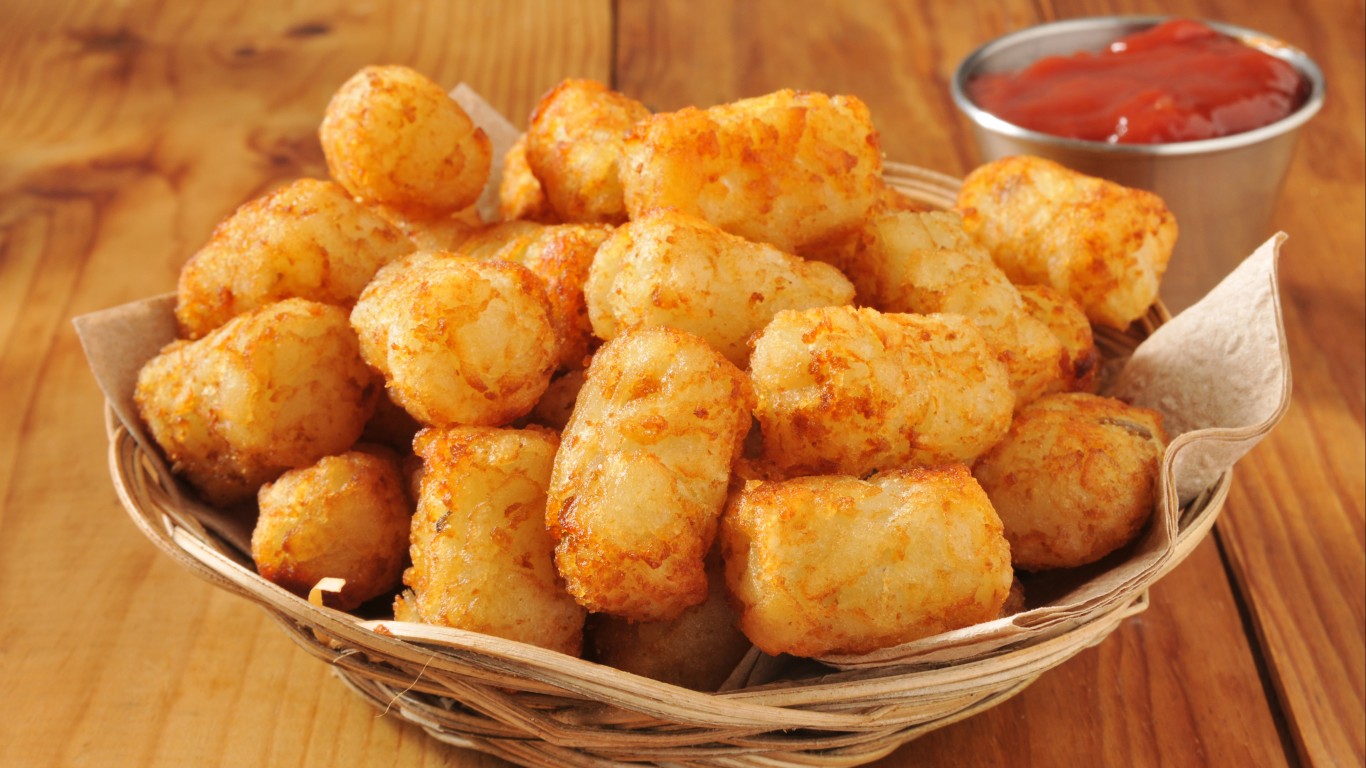
Oregon
> Iconic dish: Tater Tots
Tater Tots were invented in Oregon, back in 1953. F. Nephi Grigg and Golden Grigg, the founders of Ore-Ida (whose main production facility is in Ontario, Oregon) were looking for something to do with leftover potato scraps, so they decided to grate them along with flour and seasoning and feed them through an extruder into a deep-fryer. The end result was a crispy, creamy masterpiece, and the tot was born. Though the term is widely used for similar items (some restaurants make their own), “Tater Tots” remains a registered trademark of Ore-Ida.
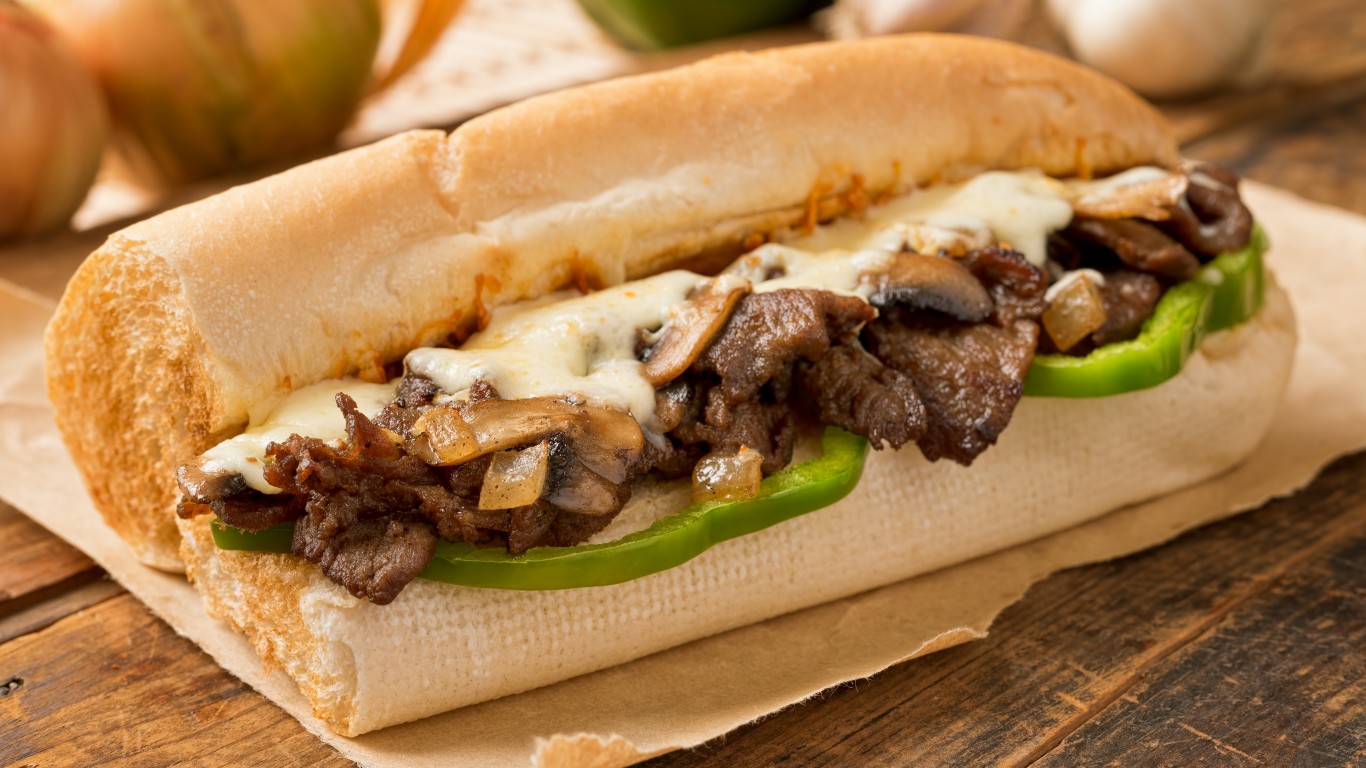
Pennsylvania
> Iconic dish: Philly cheesesteak
Some Philadelphia locals may be partial to the city’s famous roast pork sandwich with broccoli rabe and provolone, but there’s no denying that the cheesesteak is Pennsylvania’s most iconic culinary export. It was supposedly invented in Philadelphia by hot dog stand owners Pat and Harry Olivieri in the 1930s, and their stand, Pat’s remains one of the most famous places for the sandwich (it’s closest longtime competitor, Geno’s, is right across the street). It’s a simple sandwich, made by piling thinly-shaved beef and melted cheese onto a long roll; several cheeses are usually available but Cheez Whiz is the most common, and it can be ordered “wit” or “wit out” onions.
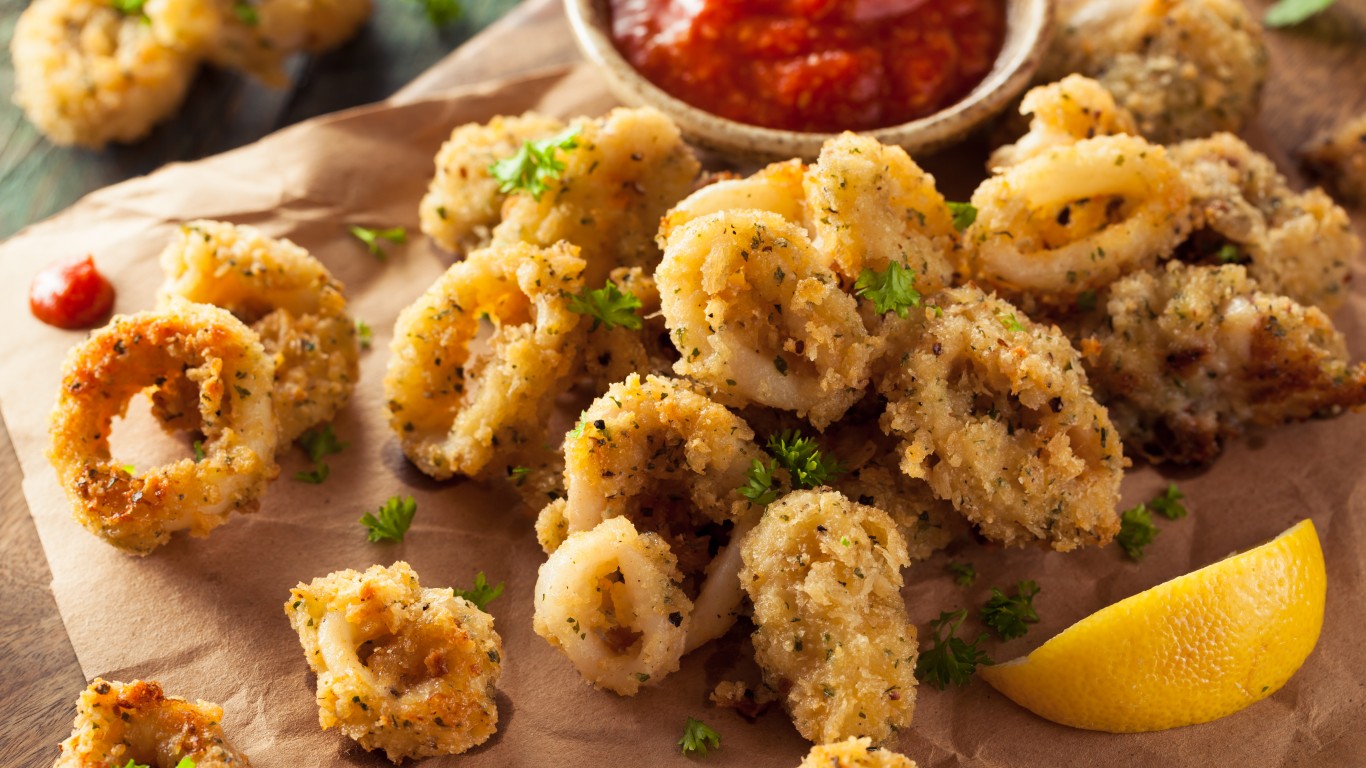
Rhode Island
> Iconic dish: Fried calamari
Fried calamari is a staple of Italian restaurants nationwide, but the simple dish of breaded and fried squid rings is actually near and dear to the hearts of Rhode Islanders. Little Rhody is has the largest squid fishery on the East Coast, valued at about $28 million a year. Further proof of its importance to the state: Fried calamari was featured during the virtual roll call for Rhode Island delegates at the 2020 Democratic National Convention.
[in-text-ad-2]
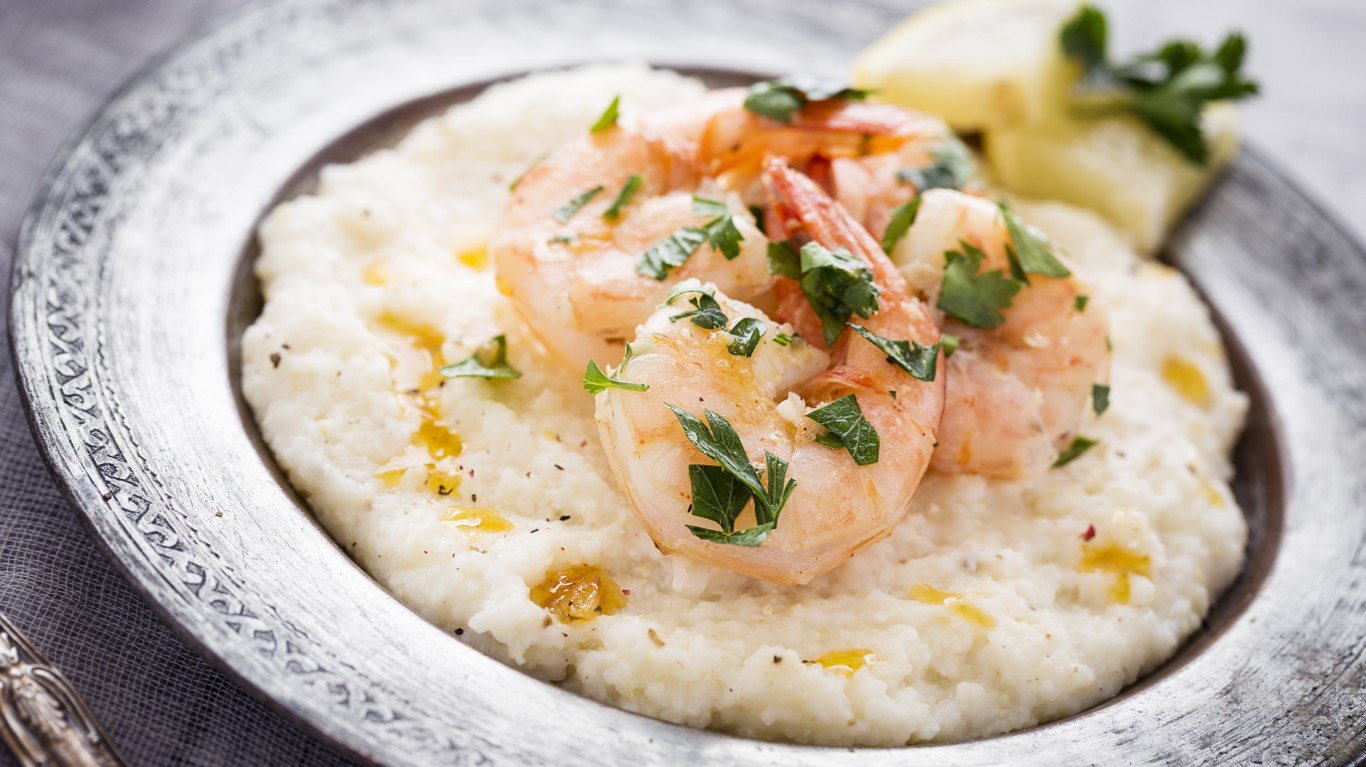
South Carolina
> Iconic dish: Shrimp and grits
Shrimp and grits actually got its start as a breakfast dish, but it’s become so popular in recent decades that it’s equally accepted at lunch and dinner. It’s a traditional dish of the South Carolina Lowcountry, and is a standby at restaurants across the state, especially in Charleston. To make the dish, grits (coarse-ground cornmeal) are made creamy with plenty of milk and butter, and locally-sourced (ideally) shrimp are served atop it, occasionally with additions including bacon, green onions, and gravy.
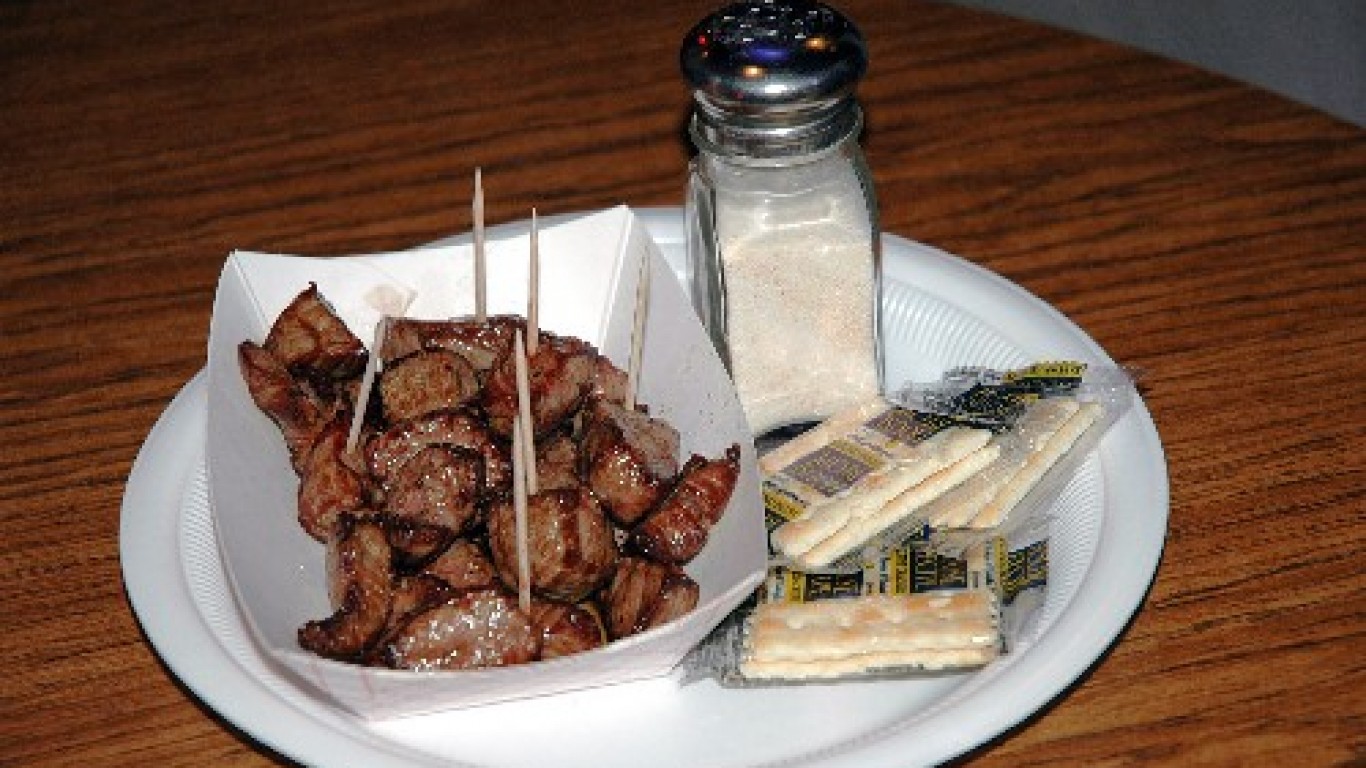
South Dakota
> Iconic dish: Chislic
Named the official state “nosh” of South Dakota but rarely seen on menus outside of the state, chislic is a simple snack made by deep-frying cubes of red meat (usually beef but also occasionally lamb, mutton, or venison) to medium rare, seasoning them with garlic salt and seasoning salt, and serving them with toothpicks alongside crackers.
[in-text-ad]
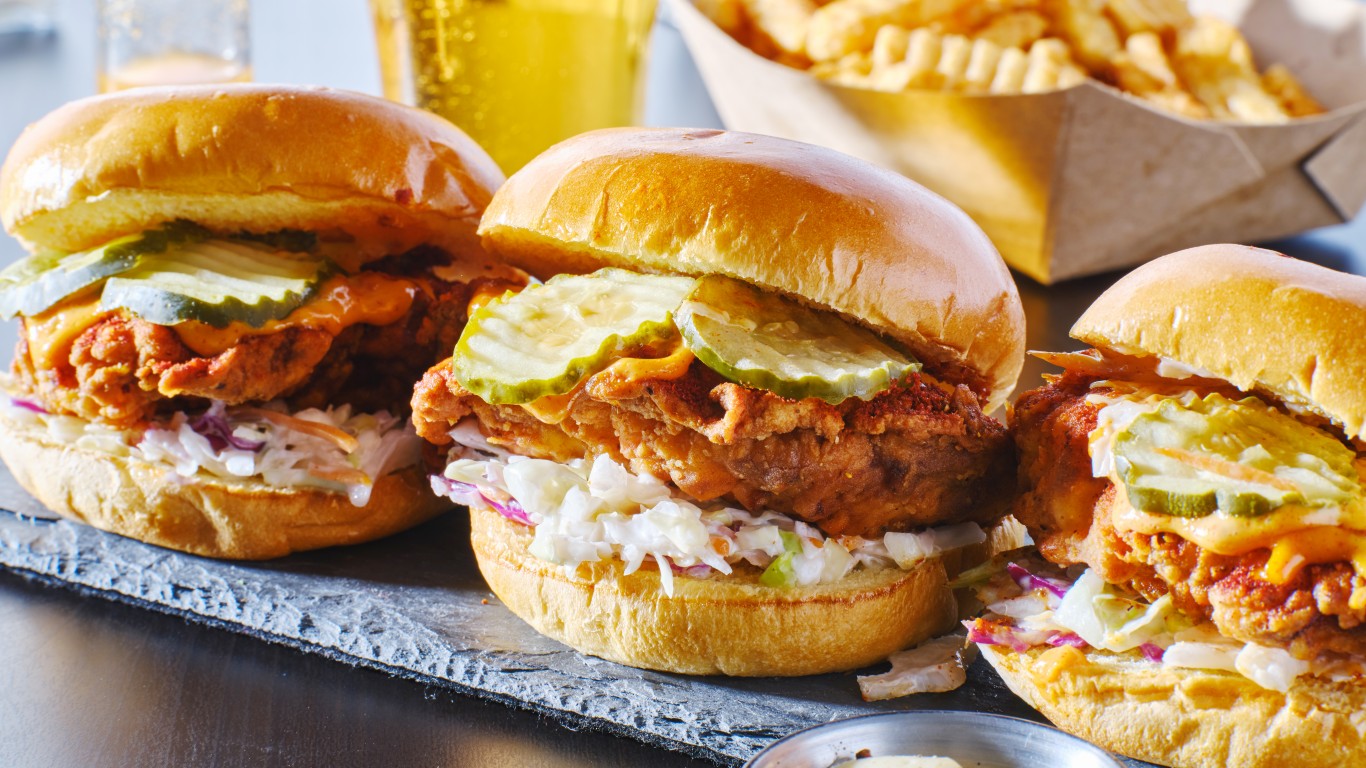
Tennessee
> Iconic dish: Nashville hot chicken
Nashville-style hot chicken is simply everywhere these days, from fast food chains to sports bars, but nowhere is it more popular than in the city of its birth. Legend has it that it was invented in the 1930s at a restaurant called Prince’s Hot Chicken Shack, which remains one of the most famous purveyors of the dish. To make this legendary (and legendarily spicy) dish, chicken is breaded and fried, but before being served it’s dunked into a vat of hot oil or lard that’s been kicked up with ungodly amounts of cayenne pepper (sometimes the molten spice paste is also brushed on by hand). Several levels of heat are usually offered, but be warned that when they say “hot,” they mean it.
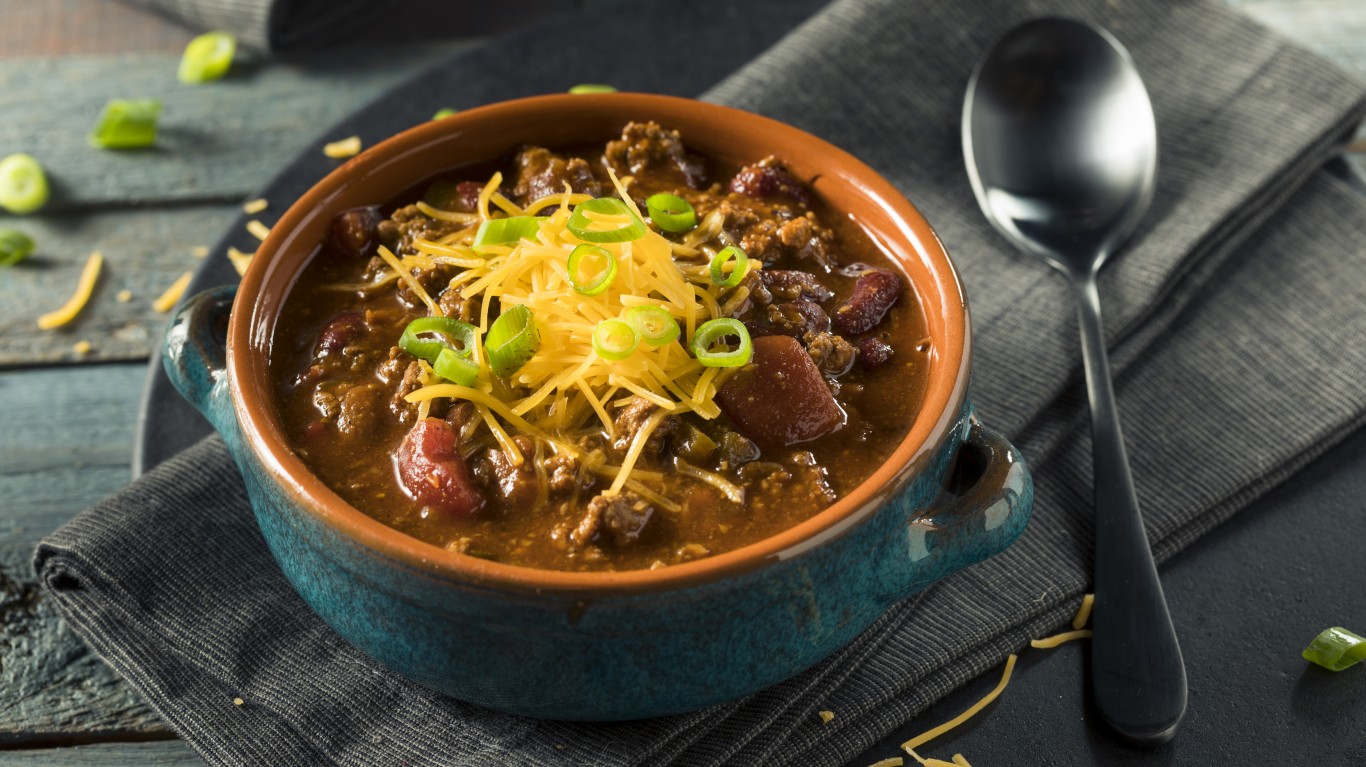
Texas
> Iconic dish: Chili con carne
Just like Cincinnati, Texas has a style of chili all its own, and historians agree that this is actually the original chili, as brought to the state by Mexicans in the mid-1800s. Don’t expect to see any beans in this chili; in its purest form, Texas-style chili con carne is just what the name implies: chiles with meat. True Texas chili (affectionately dubbed a “bowl of red”) is made by stewing chunks of beef with a variety of spices as well as fresh and dried chile peppers, and thickened up with a bit of masa. And that’s it: no tomatoes, no beans, no frills. Toppings including cilantro, grated cheese, avocado are optional, and tortillas are usually served on the side.

Utah
> Iconic dish: Jell-O
For most, Jell-O is an old-fashioned, slightly boring dessert. But in Utah, it’s a way of life. In fact, Utah consumes more Jell-O than any other state, and it was named the state snack in 2001. So why is this humble treat so popular in the Beehive State? One theory is that during the mid-1900s, Mormon housewives with many mouths to feed turned to the humble foodstuff as a colorful dessert, and generations developed a taste for it that never went away.
[in-text-ad-2]
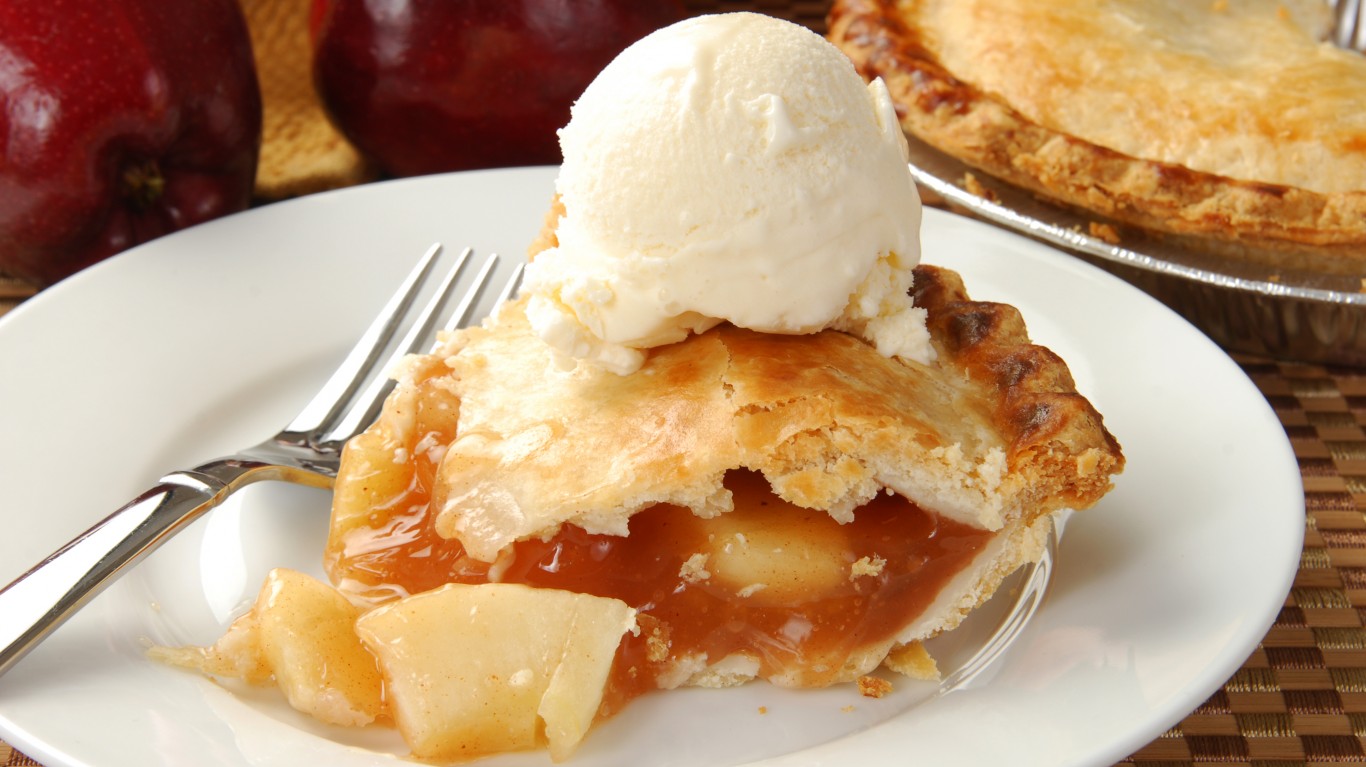
Vermont
> Iconic dish: Apple pie
Apple orchards are abundant in Vermont, and apples are so abundant there that they were named the state fruit. So it goes without saying that where there’s apples, there’s apple pie. Just about every restaurant and family in Vermont has its own recipe for apple pie, but there’s only one rule: the apples need to be front-and-center.
Virginia
> Iconic dish: Country ham
Unlike the ham you’ll find on your diner breakfast platter, country ham is a true delicacy, made by salt-curing ham for up to three months before smoking it over hardwood. It’s typically eaten on its own or perhaps tucked into a warm biscuit (perhaps with some pimento cheese). It’s salty, smoky, and a real-deal artisan product.
[in-text-ad]
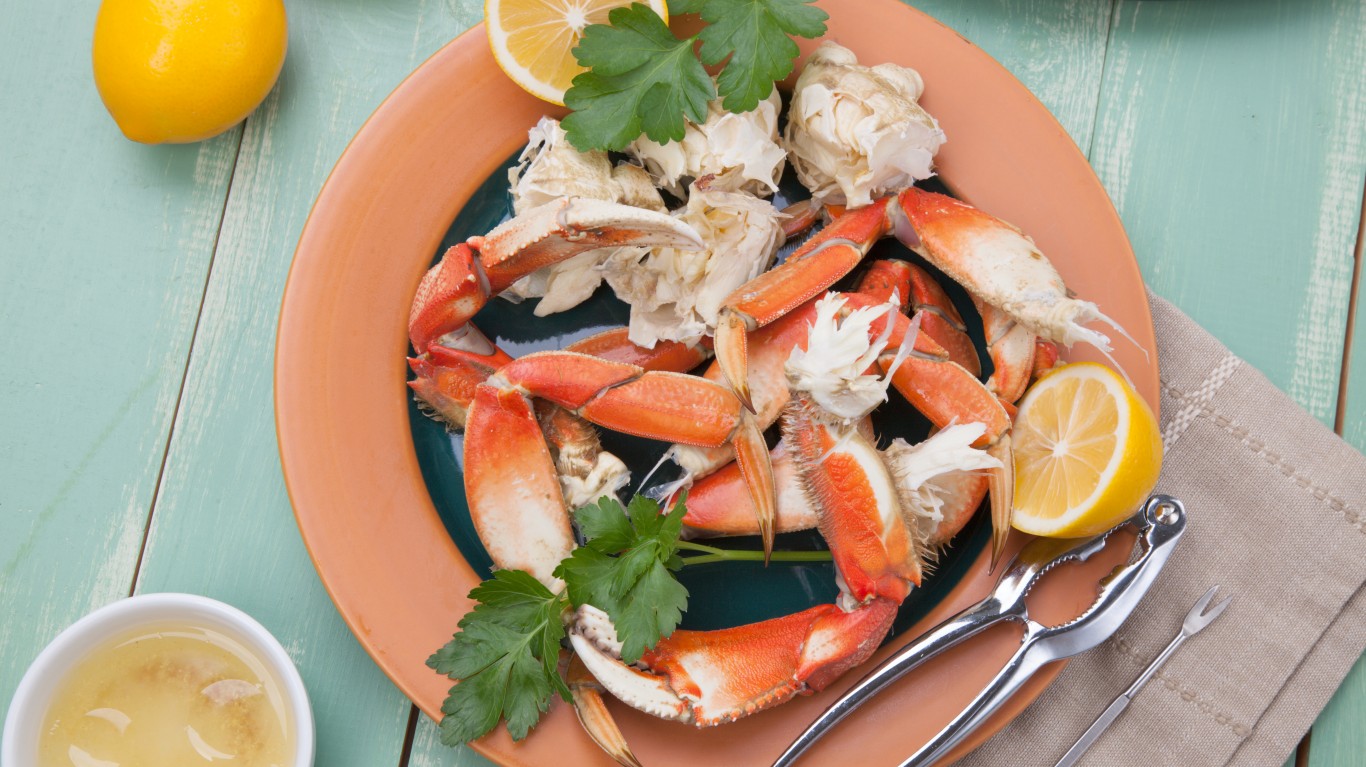
Washington
> Iconic dish: Dungeness crab
Dungeness crab is a beloved delicacy in the Pacific Northwest, especially in Washington State. It’s prized for its sweet, mild flavor, and is best enjoyed when super-fresh and simply boiled and cracked, but it also turns up in plenty of regional dishes like crab Louie and cioppino. Prime Dungeness crab season is during the winter months, when restaurants throughout Washington, especially waterfront seafood shacks, proudly serve the beloved crustacean.
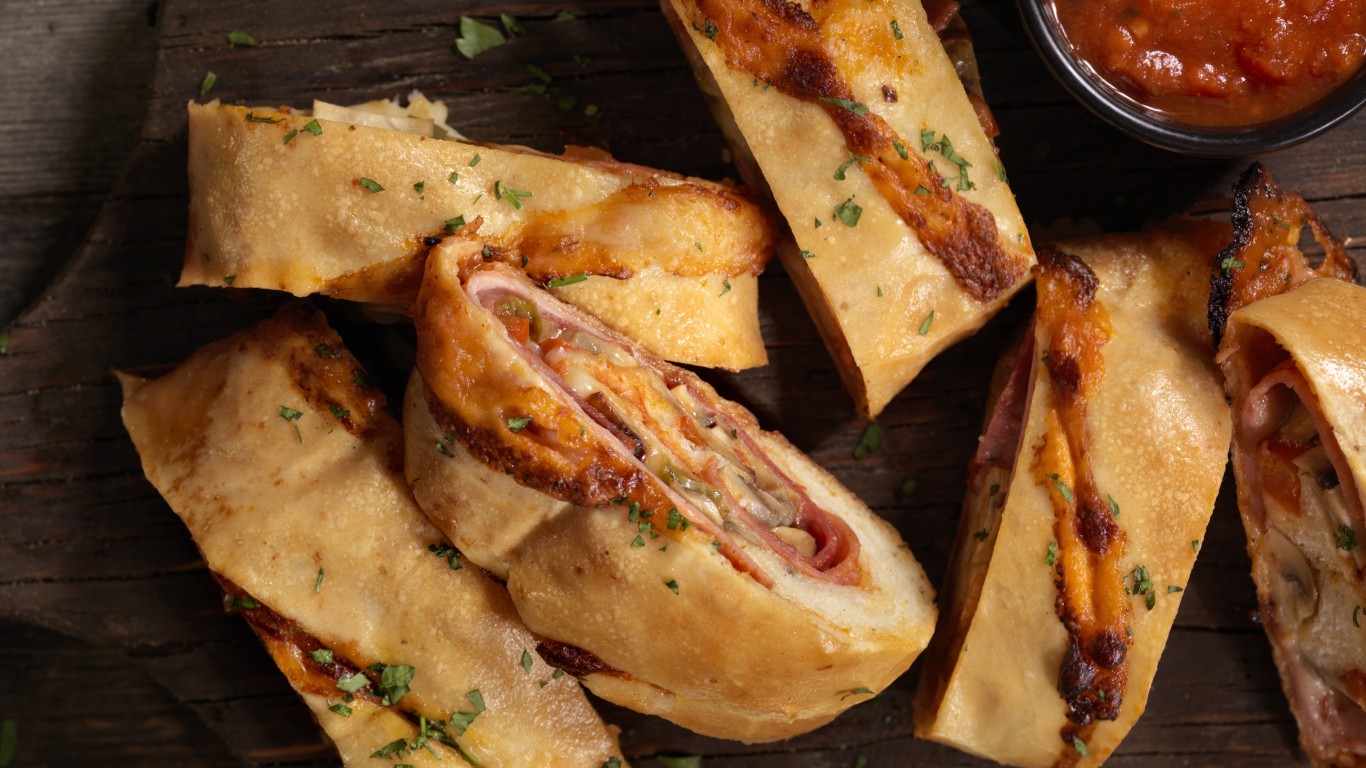
West Virginia
> Iconic dish: Pepperoni rolls
Outside of West Virginia, pepperoni rolls are usually found at pizzerias, made by rolling up pepperoni with pizza dough. In West Virginia, however, pepperoni rolls are small rolls that are baked with pepperoni inside, either in coins or sticks, and possibly along with cheese. As it bakes, the oil from the pepperoni seeps into the dough, and the end result is a savory, slightly spicy snack, equally popular at bakeries and gas stations.
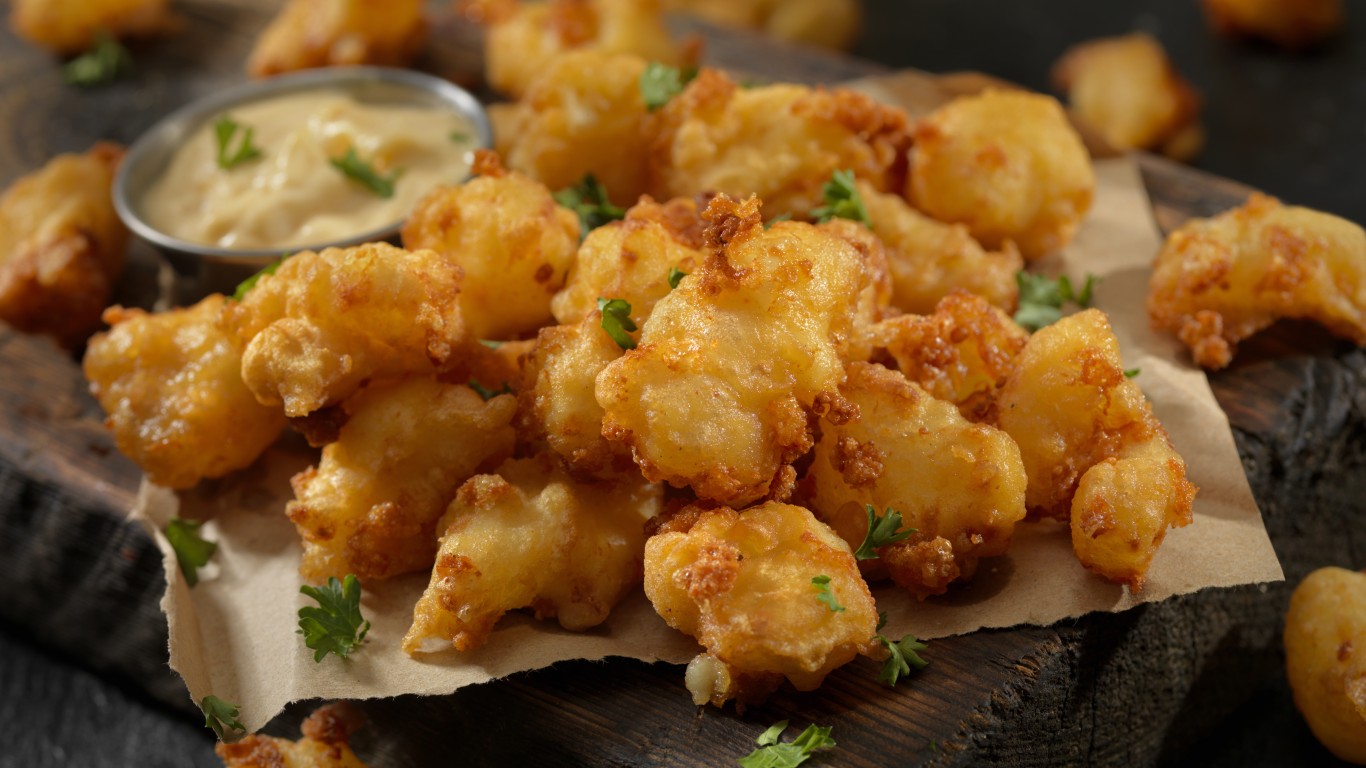
Wisconsin
> Iconic dish: Cheese curds
Wisconsin is responsible for more than a quarter of all cheese produced in the United States (and nearly half of the country’s specialty cheese), and no other state is quite as closely associated with cheese. Cheese curds are an important part of the cheesemaking process; curds (solids) are separated from whey (liquid), strained, and then shaped into molds before being aged into the finished cheese. Because cheese curds are fresh, they have a very mild flavor and a “squeaky” texture when chewed; they also don’t last very long before going bad, so they’re not commonly found too far from the dairy where they’re made. In Wisconsin, you’ll find cheese curds sold on their own for snacking or battered and deep-fried on bar menus; head north of the border and they’re also a primary ingredient in the beloved Canadian dish, poutine.
[in-text-ad-2]
Wyoming
> Iconic dish: Buffalo jerky
If you’re looking for a home where the buffalo roam, then look no further than Wyoming. The American bison, more commonly known as buffalo, is the state mammal of the Cowboy State, and thanks to conservation efforts thousands now roam the state (up from only 400 or so across the whole country in the 1880s). Only a handful of states allow free-range buffalo hunting, including Wyoming, and making jerky is a great way to preserve the meat of this prized animal. From truck stops to specialty shops to butcher shops, you’ll find buffalo jerky all throughout Wyoming.
Are You Ahead, or Behind on Retirement? (sponsor)
If you’re one of the over 4 Million Americans set to retire this year, you may want to pay attention.
Finding a financial advisor who puts your interest first can be the difference between a rich retirement and barely getting by, and today it’s easier than ever. SmartAsset’s free tool matches you with up to three fiduciary financial advisors that serve your area in minutes. Each advisor has been carefully vetted, and must act in your best interests. Start your search now.
Don’t waste another minute; get started right here and help your retirement dreams become a retirement reality.
Thank you for reading! Have some feedback for us?
Contact the 24/7 Wall St. editorial team.
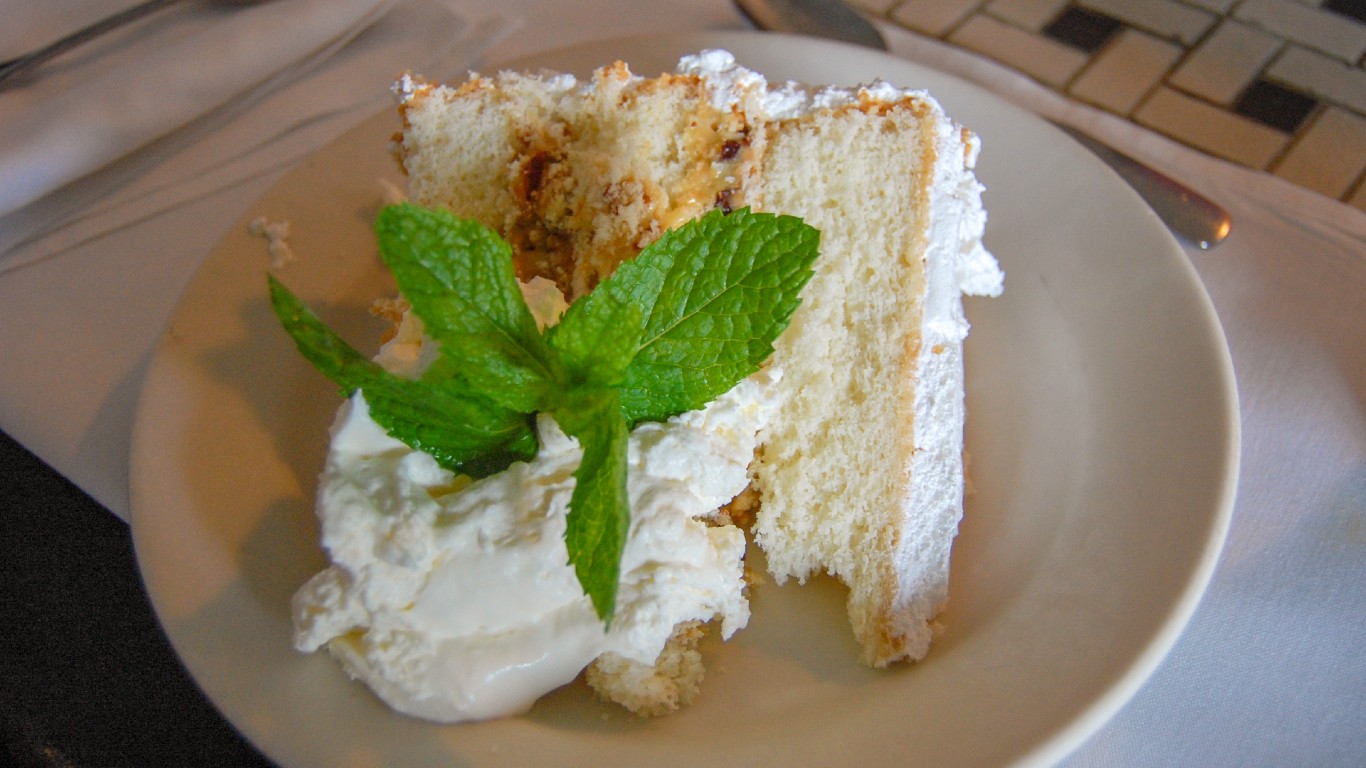
 24/7 Wall St.
24/7 Wall St.
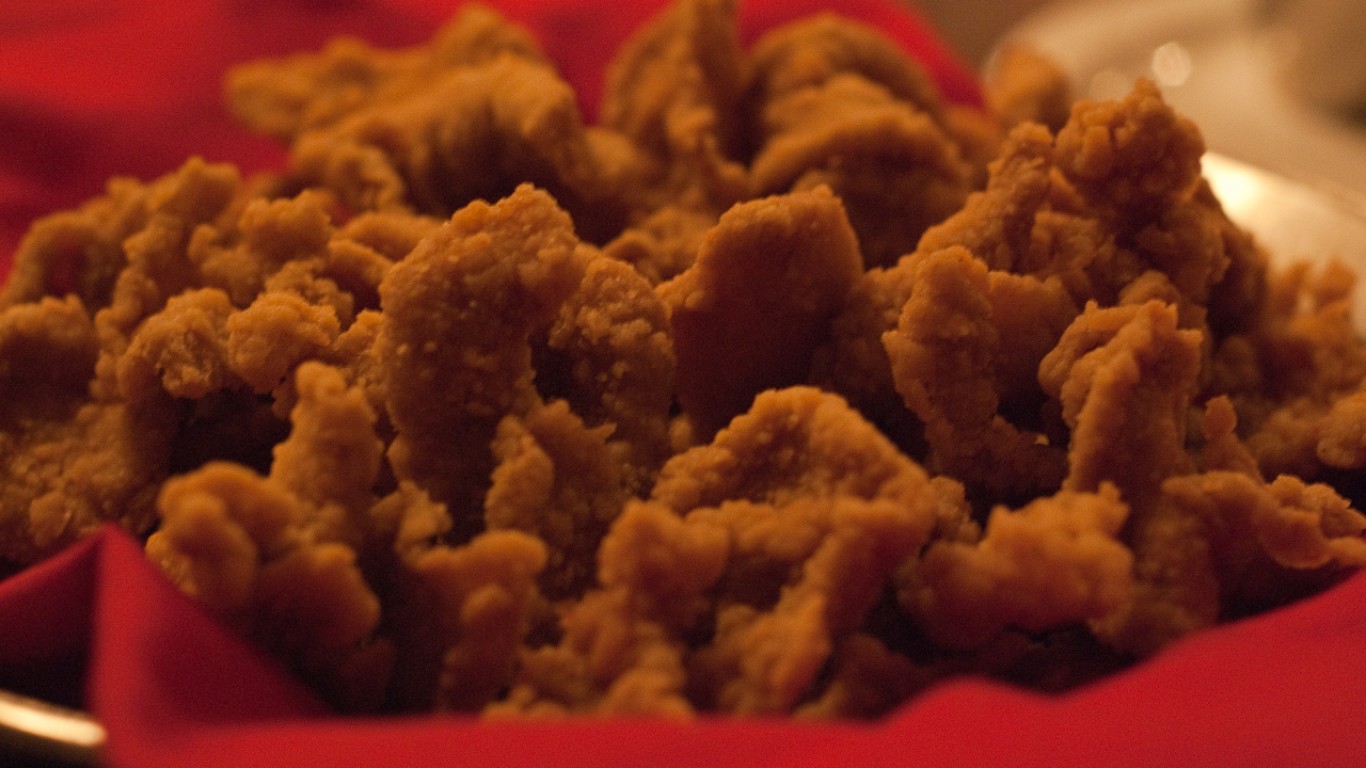

 24/7 Wall St.
24/7 Wall St.
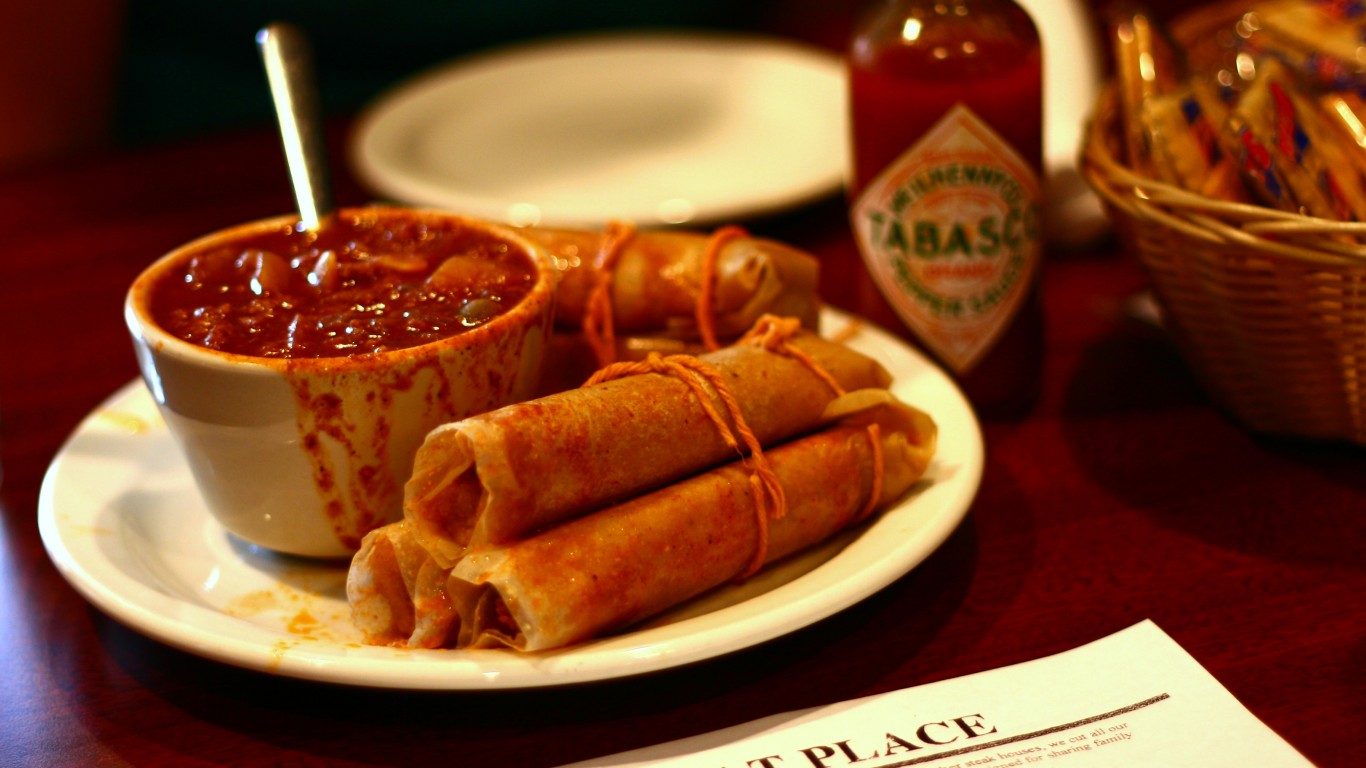
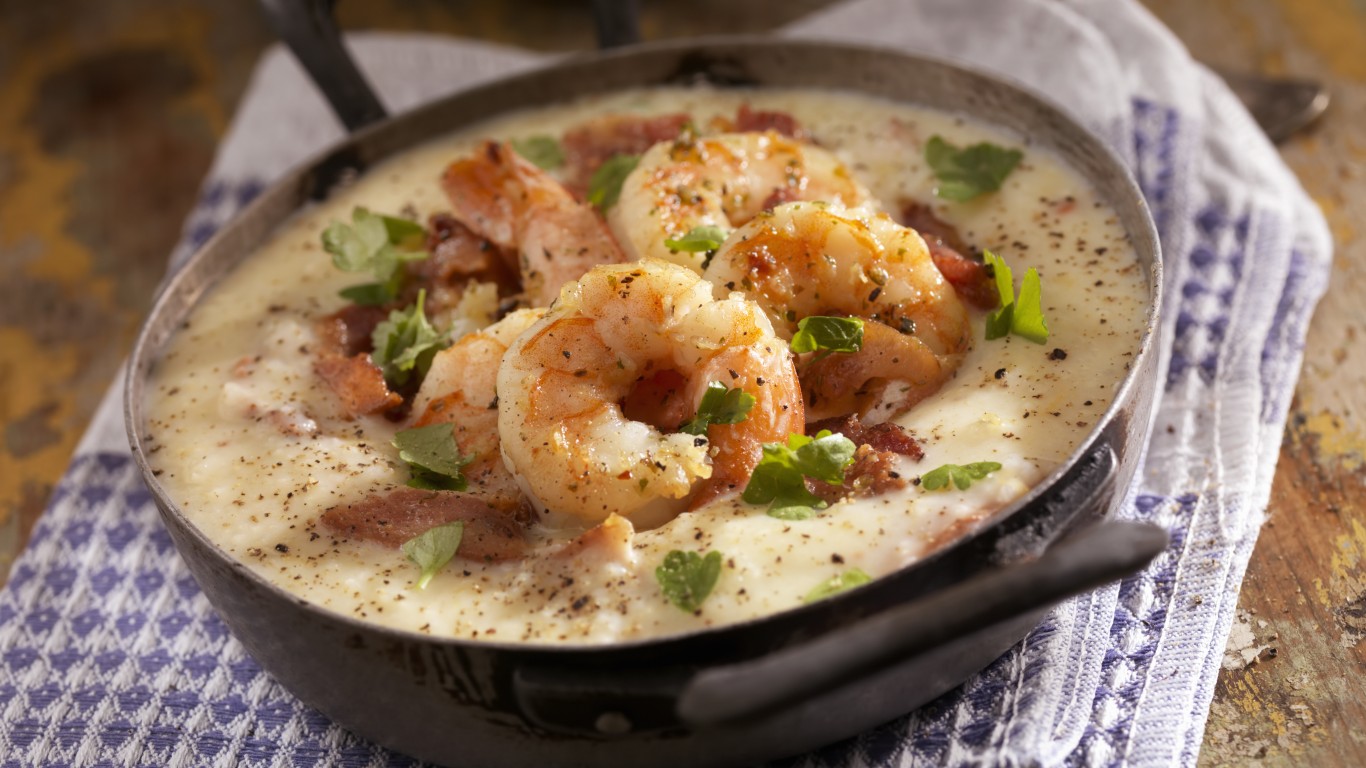 24/7 Wall St.
24/7 Wall St.